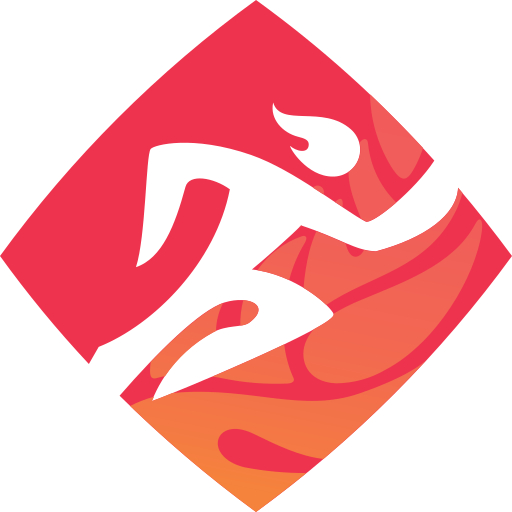Athletics is an Olympic sport that combines the following complex sections: walking, running, jumping, throwing and all-around. Each of them is divided into types:
- racewalking;
- sprint, middle-distance, long-distance running;
- steeplechase, hurdling, relay race;
- vertical jumps: high jump, pole vault;
- horizontal jumps: long jump, triple jump;
- discus, javelin, hammer throw, shot put;
- all-around - decathlon (men) and heptathlon (women).
Dynamic New Athletics is the most multifaceted and technically complex sport. The decision to include this new format belongs to the European Athletics Association.
In 2017 the association signed an agreement with the European Olympic Committees (EOC) on the introduction of the new program. The main goal is to create a friendly athletics format for young people and, thereby, attract a new audience of fans.
At the same time, it was decided to form 9 types (individual and relay races) in which medals will be played out. In addition, another set of awards will be given to the best teams in the team competition. Thus, the strongest athletes will be determined in 10 types of programs.
Unlike traditional athletics, DNA assumes that only one type of program can be held at the stadium at one time, so that all viewers' attention is focused on it.
Athletics will present a combined program at the 2nd European Games: running, including race and sprint hurdling, as well as technical types such as jumping and throwing.
In accordance with the new DNA regulations, each match has competitions in the following forms:
- for women – 100m dash, 100m hurdles 100 m, long jump, javelin throw;
- for men - 100 m dash, 110 m hurdles, high jump;
- mixed - 4x400m relay, combined pursuit racing (800m – 600m - 400m - 200m).
Sprint is a complex of athletics disciplines, where athletes compete in running over short distances (up to 400m) in a stadium. The athlete runs with the greatest speed, but at the same time overcomes very small segments of the distance. Such runners are called sprinters.
From written sources it is known that the first Olympics took place in 776 BC in Olympia, where running was one of the main disciplines.
 Marathon runner. Children's Encyclopedia, v.7
Marathon runner. Children's Encyclopedia, v.7
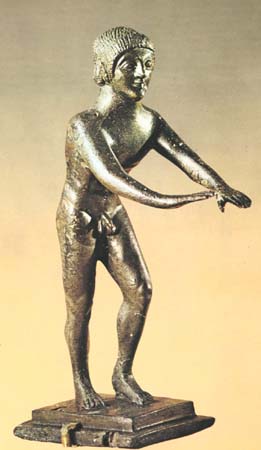 Runner at the start. Bronze statuette. 480-470 BC https://megabook.ru
Runner at the start. Bronze statuette. 480-470 BC https://megabook.ru
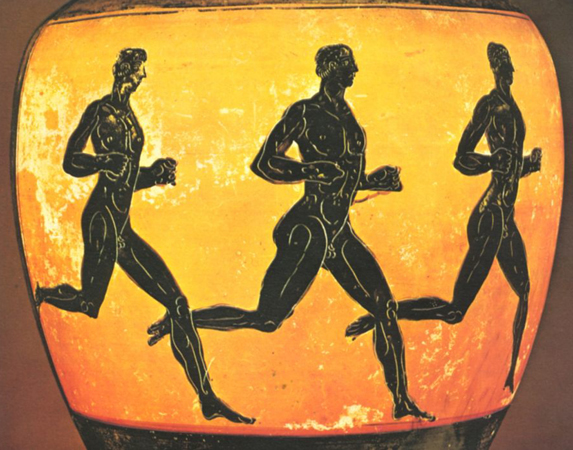 Runner in dolichos. Painted Panathenaic amphora. 333 BC https://megabook.ru
Runner in dolichos. Painted Panathenaic amphora. 333 BC https://megabook.ru
The ancient surviving Greek inscription, carved on the rock says: “If you want to be strong − run, you want to be beautiful − run, you want to be smart − run”. Athletes didn’t ran in a circle, but back and forth, that imitated the movement of Greek troops.
 Paintings on Panathenaic amphorae https://www.rienasemettre.fr
Paintings on Panathenaic amphorae https://www.rienasemettre.fr
Running for a short distance was the only sport from the 1st to the 13th Olympics (724 BC). The word "stadium" comes from the measure of the distance (“stadiodromos”).
The athletes did not know the “low start”, but started from a special threshold, “balbis”, there were made pits for the rest of the toes. Another stone threshold, “telos”, was made at the end of the track finish. False starts were strictly forbidden.
In the 4th century BC Greeks invented the starting device, “hisplex”, a wooden starting gate that guaranteed a fair start.
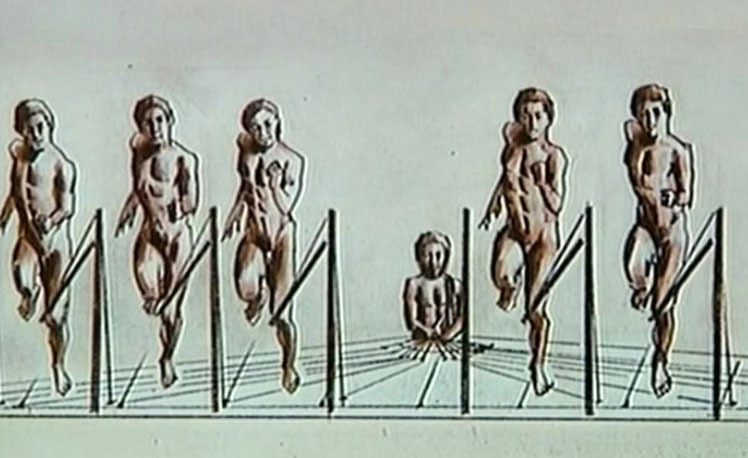 Starting gate http://interesnik.net
Starting gate http://interesnik.net
Further development of the running as an independent discipline began only in the 18th century in England. There were held competitions on large roads between cities or on the tracks of hippodromes. The promotion of running in educational institutions of Oxford, London, and Cambridge began in 1837.
Since the second half of the 19th century, athletics has been actively developing in America.
 Athletes are training to participate in the 1896 Olympics. https://nogibogi.com
Athletes are training to participate in the 1896 Olympics. https://nogibogi.com
In 1868 young Americans picked up the idea of London youth to hold athletics competitions in all major cities, which contributed to the popularization of competitions in many US states.
At the first 1896 Olympics in Athens, American athletes won 9 gold medals out of 12. The United States retained almost unbroken hegemony till the 1952 Olympics.
In these Olympics American sprinter Thomas Burke used a low start for the first time, touching the ground with his knee. When he was still at the start, the audience laughed and shouted: “Get up off the ground!” But he won gold medals at the distances of 100m and 400m (12.0 seconds and 54.2 seconds). Now it is impossible to imagine a single competitive race for short distances without a low start.
 1896.jpg Thomas Burke on the distance of 100m. https://sverigesradio.se
1896.jpg Thomas Burke on the distance of 100m. https://sverigesradio.se
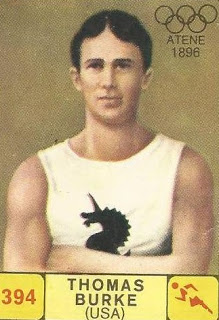 Thomas Burke. http://og-eua.blogspot.com
Thomas Burke. http://og-eua.blogspot.com
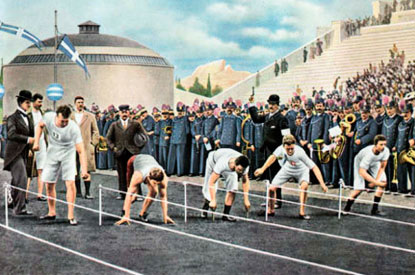 100m sprint start: Thomas Burke is second from left side http://sportwiki.to
100m sprint start: Thomas Burke is second from left side http://sportwiki.to
 Archie Khan with a cup https://rusatletik.ru
Archie Khan with a cup https://rusatletik.ru
At the III Olympic Games, an outstanding American athlete Charles Archibald "Archie" Hahn won two sprint distances due to a phenomenal spurt at the start, setting up a record at 200m distance (21.6 seconds), which was broken in 28 years, in 1932.
The world record with a phenomenal time of 9.58 seconds at a distance of 100 meters for men is set by Jamaican athlete Usain Bolt in Berlin in 2009 and to this day no one can beat it. At the same World Championships in Athletics in Berlin, he set the second unsurpassed world record at a 200 m distance, 19.19 seconds. Usain Bolt is the fastest sprinter in history at 100 and 200 meters.
 Usain Bolt https://sporter.md
Usain Bolt https://sporter.md
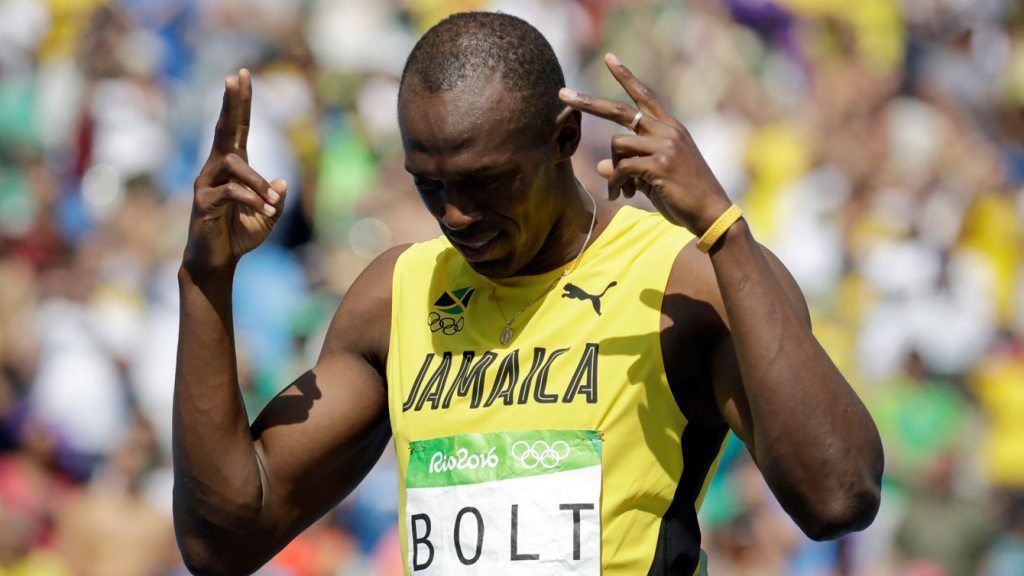 Usain Bolt https://olympic.ca
Usain Bolt https://olympic.ca
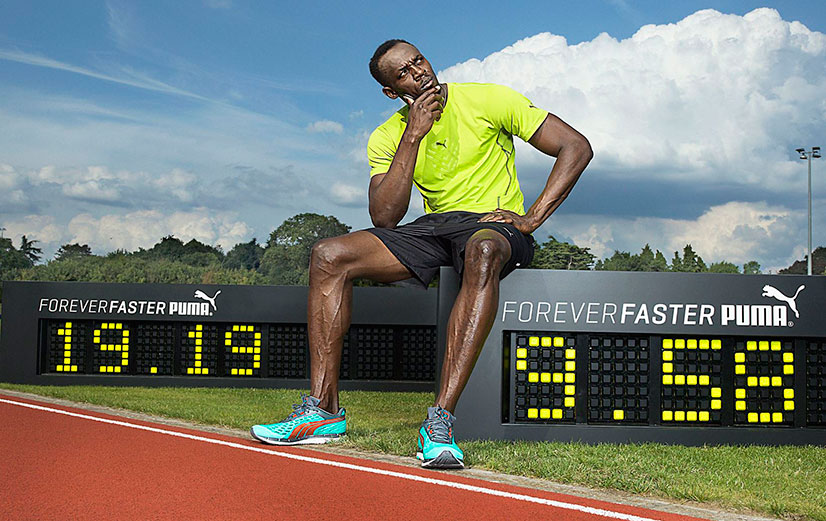 Usain Bolt http://keeprun.ru
Usain Bolt http://keeprun.ru
In 1928 women joined battle for the Olympic awards in athletics. 100m and 800m distances, as well as a 4 x 100m relay were set for them.
The 200m distance for women’s running was included in the programme of the 1948 Olympics in London. At this competition, the 30-year-old mother of two children, Francina Elsje (Fanny) Blankers-Koen sensationally won both sprint distances, she ran 100m for 11.9 seconds, and 200m for 24.4 seconds. For her achievements this Holland athlete received the nickname "The Flying Housewife". Fanny became the first woman who won 4 gold medals at one Olympics.
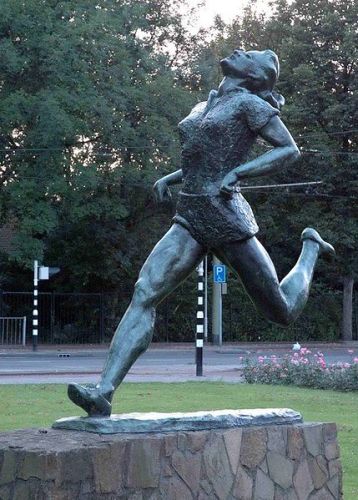 Monument dedicated to Fanny Blankers-Koen in Rotterdam. http://athletics-sport.info
Monument dedicated to Fanny Blankers-Koen in Rotterdam. http://athletics-sport.info
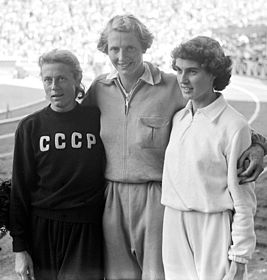 Fanny Blankers-Koen https://www.peoplelife.ru
Fanny Blankers-Koen https://www.peoplelife.ru
American athlete Florence Griffith-Joyner set the women's record for 100m distance, 10.49 seconds. This world record is still unbeaten.
 Florence Griffith-Joyner set the current 100m and 200m world records https://nogibogi.com
Florence Griffith-Joyner set the current 100m and 200m world records https://nogibogi.com
Before the 1966 European Athletics Championship, the results were measured by a manual stopwatch, the accuracy of which was a tenth of a second. Then they began to use electronic timekeeping, but the registration of world records until 1975 were manual. Than the records began to be recorded with an electronic stopwatch with the accuracy of a one hundredth.
In 1892 the first public sports organization was organized in Belarus: Minsk Society of Sports Amateurs, which was headed by the count Karol Hutten-Czapski. Governor Prince N. Trubetskoy and other representatives of the upper class of society: nobles, financiers, industrialists, doctors.
According to K.A. Kulinkovich and N.V. Mogilny, athletics as a sport originated in Belarus in 1913, when the Club of Sport Amateurs was created in Gomel. The first competitions were held in three disciplines, including running, jumping and throwing.
Sport began to gain popularity. Step by step sports clubs appeared in Minsk, Mogilev and Brest. Athletes-enthusiasts and instructors-methodologists who have been trained in military schools or at the famous classes by P.F. Lesgaft, actively conducted sports work.
In 1914 an athlete from Minsk Esmanovich took part in the Second All-Russian Olympiad in Riga. But the development of athletics in that time were difficult because of the absence of stadiums and sports grounds.
In 1919 the First Olympiad in athletics, attended by 240 athletes, was held in Vitebsk region. They began the construction of the simplest sports facilities in east regions of Belarus.
In 1922 the first athletics competitions with the participation of athletes from Moscow and Smolensk (100 m and 1500 m, jumps in length and height, discus throwing and shot put) were held in Minsk.
The first record in the 100m for men in Belarus was made by V. Svechnikov, who showed the result of 12 seconds.
In 1924–1925 friendly competitions which included the 100m sprint, were held on the “Profintern” sports ground.
The first record in the 100m for women was made by N. Belevich in 1926 (14.3 seconds in a 100m sprint).
On July 11, 1930 the All-Belarusian Stadium named after the 10th anniversary of the liberation of Belarus from the White Poles opened (it was almost completely destroyed during the war years and wasn’t restored in its original form), on the tracks of which, after 6 years, the match of athletes from Minsk, Vitebsk, Gomel, Bobruisk and Mogilev took place. Athletes from Grodno, Brest and Pinsk, being residents of Western Belarus, participated in the Polish championships.
In 1938 the first championship of Belarus in athletics between voluntary sports societies took place.
V. Chernov (11.2 seconds in a 100m sprint in 1928), N. Yanchevsky (10.8 seconds in 1939), N. Andryushchenko (10.4 seconds in 1956) achieved good results in a short sprint.
In 1956 the first Olympic medals were won by Belarusian athletes. Every year Soviet athletes looked more confidently on the international arena.
It has to be noted the story of our countryman Vladislav Sapey, the strongest USSR sprinter. Having run a 100m sprint at 10 seconds at international competitions in memory of the Znamensky brothers in the summer of 1968 in Leningrad, he showed a phenomenal result for that time. The Belarusian athlete set two records at once, the Republican one and the All-Union in the 100m sprint, repeated the European and World records. In Belarus no one has managed to beat this achievement.
 Vladislav Sapey, Belarusian record-holder http://athletics-sport.info
Vladislav Sapey, Belarusian record-holder http://athletics-sport.info
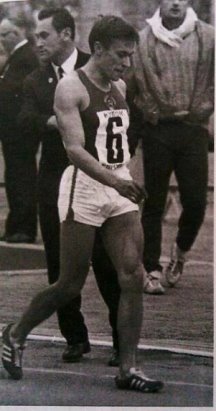 European Cup holder, Vladislav Sapey http://sprinterol.blogspot.com
European Cup holder, Vladislav Sapey http://sprinterol.blogspot.com
 V.Sapey, L.Geishtor, Goltsev, Kharitonov, Savchenko. 1968 http://physcult.gsu.by
V.Sapey, L.Geishtor, Goltsev, Kharitonov, Savchenko. 1968 http://physcult.gsu.by
The first record holder in the sprint is Nina Belevich, who showed a high result for that time (14.3 seconds in 1926). Improving the system of training athletes contributed to the growth of their sporting achievements. In subsequent years, record holders became the Zoya Lovetskaya (14.0 seconds in 1936), Anna Lyuppen (12.5 seconds in 1948), Maria Itkina (11.4 seconds in 1960), Natalia Kozharnovich (11.3 seconds in 1975).
In USSR our girls repeatedly updated the country's records, but Maria Itkina achieved the greatest success. Belarusian athlete entered the Soviet history as the athlete with the biggest number of medals in the former USSR. She successfully competed in 100m, 200m and 400m sprints, as well as in various combinations of sprint relay races.
Starting at three European championships in 1954, 1958 and 1962, Maria Itkina won four gold medals (200m, 400m, 4 × 100m relay) and one bronze medal (200m). In total Maria won 32 medals at 11 USSR championships. She made world records in 400m four times.
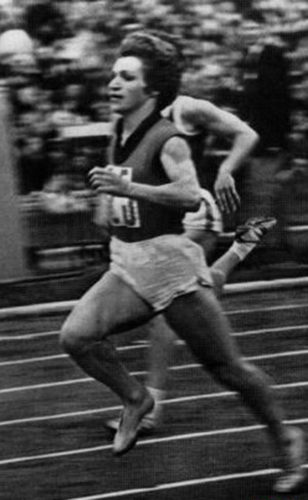 Maria Itkina, the best USSR athlete in 1959. https://delaemvmeste.by
Maria Itkina, the best USSR athlete in 1959. https://delaemvmeste.by
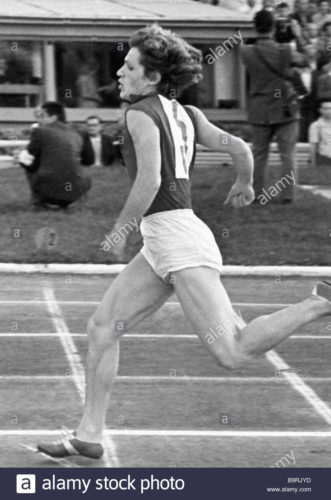 Maria Itkina, the best USSR athlete in 1961 https://delaemvmeste.by
Maria Itkina, the best USSR athlete in 1961 https://delaemvmeste.by
In 1991, the Belarusian Athletics Federation became part of the International Amateur Athletics Federation.
On March 22, 1991 the National Olympic Committee of the Republic of Belarus was established.
In March 1991 the BAF was admitted to the International Association of Athletics Federations (International Association of Athletics Federations) as an independent federation.
Since 1993 the Belarusian national team in the official international competitions performs as an independent team.
At the 2004 Olympics in Athens, the Belarusian runner Yulia Nestsiarenka won the Olympic gold in the most prestigious discipline − 10.93 seconds in a 100m sprint, having become the sporting sensation of the year. Moreover athlete from Brest was the best in all the preliminary sprints, having set the record of Belarus, 10.92 seconds. This achievement will is the most striking sporting moment in the history of the country.
 Yulia Nestsiarenka https://www.pressball.by
Yulia Nestsiarenka https://www.pressball.by
Yulia Nestsiarenka is the bronze medalist of the 2004 European Athletics Indoor Cup. Every year a tournament named after her is held in Brest.
Athletics is perhaps one of the few sports where competition rules are constantly changing. In such a situation, training of top athletes takes a longer period. The Belarusian trainer Viktor Yaroshevich is known abroad not only as a trainer of Yulia Nestsiarenka, but also as the author of numerous teaching aids, recommendations and articles for students and teachers. A renowned sprint specialist develops an individual training program for his trainees. Thanks to this approach, his students showed good sports results. Tatiana Starinskaya and Alexander Nevdah became winners of the championships of Belarus and participants of the European Cups a lot of times; Dmitry Nestsiarenka is the champion of Belarus and participant of the European Cups; Yuri Bogatko is the champion of Belarus in 2003.
Hurling is the act of running and jumping over an obstacle at speed. It is considered to be not only the most spectacular, but also one of the technically challenging kinds of running. The runner’s attention should be focused on maintaining a high pace, correct rhythm of movements and maintaining good coordination when jumping. Hurdling belongs to the group of speed/strength types of athletics.
It is believed that hurdling first appeared in the 19th century in the Kingdom of Great Britain. English shepherds competed at speed by jumping over sheep pens. Initially, fences served as hurdles. Then they were replaced by uniform "rough" poles, dug into the ground, with sharp notches and "zebra”-painted. The height of hurdles and the distance length have not been established.
 Sawhorses for sawing woods. Source: http://legkoe-delo.ru/
Sawhorses for sawing woods. Source: http://legkoe-delo.ru/
 Wooden hurdles. Source: https://sportstyle-shop.com/
Wooden hurdles. Source: https://sportstyle-shop.com/
Subsequently, the competition began to be held in places equipped with the simplest portable structures for sawing firewood, which were dug into the soil. By jumping with pursed legs, hurdlers overcame bulky and rather dangerous barriers.
Later, competitions in hurdling began to be practiced at universities. In 1837, for the first time, a message was dated about the competitions held in England among teachers at the Eton Private College. In 1853, two amateurs were mentioned who participated in a race with jumps over 50 barriers.
In the second half of the 19th century, in US sports became an important part of the American educational system. Hurdling is becoming the main discipline of the university's sports program. In 1864, the first officially set record for 120 yards was registered: 17.75 seconds, which belongs to American Daniel. The athlete ran a course jumping over 10 hurdles of 106 cm each, spaced 9 meters apart. In 1870, this height was approved by the rules of international competitions.
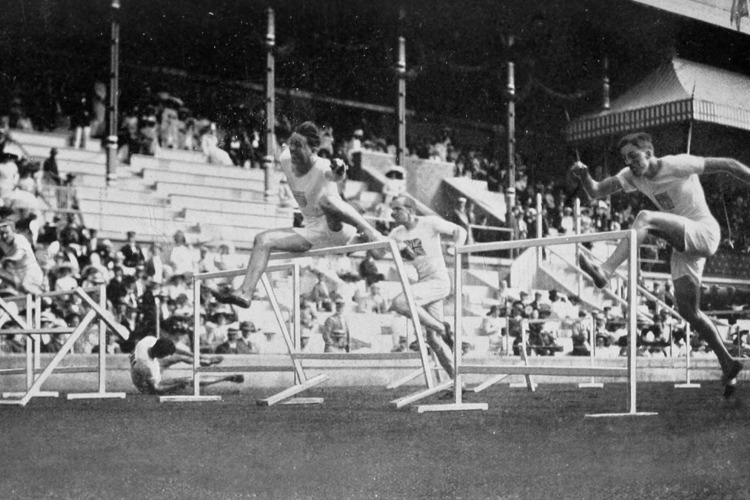 If all hurdles fall down the race does not count. Source: http://www.russianrunner.ru/
If all hurdles fall down the race does not count. Source: http://www.russianrunner.ru/
In 1896 hurdling made the Olympic debut at a distance of 110 m for men. In 1900, a new discipline, promoted by US athletes, was included in the program of the Second Olympic Games: a distance of 400 yards with 12 barriers.
At the Olympics in Paris, the graduates of the University of Pennsylvania, John Walter Tewksbury and Alvin Krenzlein, together won 9 medals.
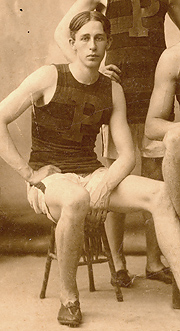 John Tewksbury at the 1900 Summer Olympics. Source: https://luna.ovh/
John Tewksbury at the 1900 Summer Olympics. Source: https://luna.ovh/
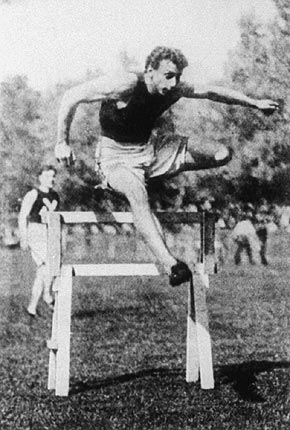 Alvin Kraenzlein at the 1900 Olympics in Paris. Source: http://athletics-sport.info/
Alvin Kraenzlein at the 1900 Olympics in Paris. Source: http://athletics-sport.info/
John Tewksbury set a record that no one can beat. The athlete from the USA became a two-time champion (200 m and 400 m) and a three-time medalist (60 m, 100 m and 200 m) at the 1900 Summer Olympics.
Alvin Kraenzlein is considered by sports experts the founder of hurdling techniques. The Olympic champion of 1900 in the 120-yard race did not jump over the barriers, but demonstrated a new technique of “stepping over them.” He is the only athlete who managed to win 4 gold medals in individual disciplines at one Olympics.
Since 1902, a new lightweight T-shaped barrier has been used.
Due to the fact that hurdlers for the fastest finish knocked down barriers and did not pay attention to the technique of running, an amendment to the competition rules was amended to disqualify a participant for the failure of three barriers.
Further improvement of the technique belongs to the winner of the 1908 Olympic Game in London at a distance of 110 m – an American Forrest Custer Smithson. The delayed removal of the lead foot made it possible to use the sprinter’s abilities to a greater extent and show an outstanding result for that time – 15.0 s. (first official world record). For more than 50 years, none of the greatest athletes could break this record.
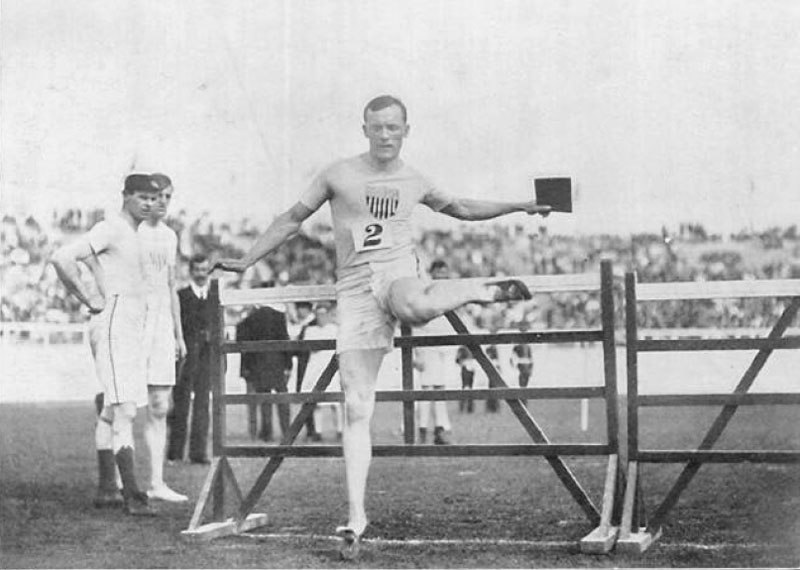 Forrest Custer Smithson. Source: https://dic.academic.ru/
Forrest Custer Smithson. Source: https://dic.academic.ru/
 Forrest Smithson on his way to winning the 110-metre hurdles final. Source: https://www.ilpost.it/
Forrest Smithson on his way to winning the 110-metre hurdles final. Source: https://www.ilpost.it/
In 1935, barriers having the shape of an inverted “T” were replaced with “L”-type barriers with a weighted base. In previous years, athletes fell while overcoming the barrier as it was hard to knock them down. A new form of the structure made it possible to significantly reduce the injuries at the time the barrier fell.
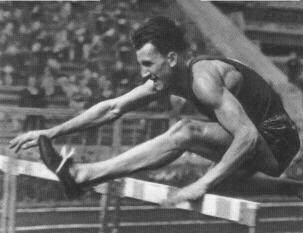 Yuri Lituev is the silver medalist of the 1952 Olympics. Source: https://www.peoples.ru/
Yuri Lituev is the silver medalist of the 1952 Olympics. Source: https://www.peoples.ru/
In 1953, at a distance of 400 meters, the Soviet athlete Yuri Lituev set a world record of 50.4 seconds, which lasted 4 years. He was the first hurdler to come to the conclusion that the key to success at this distance was the ability to run the distance between the barriers in 13 steps.
 Guy Drut (France) in flight to the world record. Source: https://www.liveinternet.ru/
Guy Drut (France) in flight to the world record. Source: https://www.liveinternet.ru/
At the 1976 Summer Olympics in Montreal, Frenchman Guy Drut won a new world record at a distance of 110 meters (13.3 seconds). He became the first European athlete who interrupted the perennial (since 1928) superiority of American athletes.
Until 1966, results at all competitions were measured by a manual stopwatch, the accuracy of which was one-tenth of a second. Then European records (since 1966) and world achievements (since 1975) began to be recorded by an electronic stopwatch with an accuracy of one hundredth.
In 1993, the world record in hurdling returned to England: C. Jackson broke a record showing a result of 12.91 seconds.
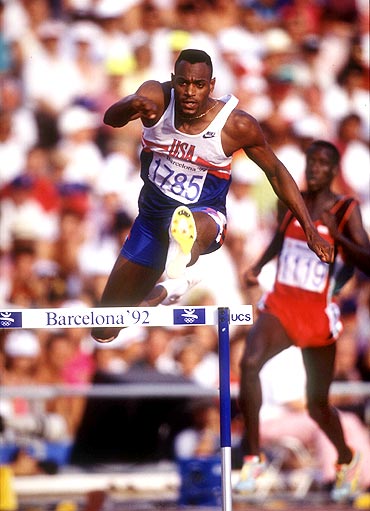 Flight to the record. Kevin Young. Source: https://alchetron.com/
Flight to the record. Kevin Young. Source: https://alchetron.com/
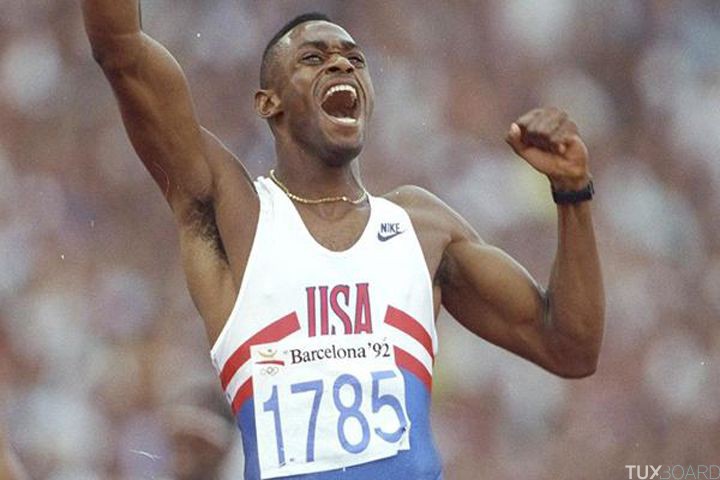 New records! Source: https://alchetron.com/
New records! Source: https://alchetron.com/
 Kevin Curtis Young, the 1992 Olympic Champion. Source: http://www.usatf.org/
Kevin Curtis Young, the 1992 Olympic Champion. Source: http://www.usatf.org/
At the 1992 Olympic Games in Barcelona, American Kevin Curtis Young set a new Olympic and world record at a distance of 400 m with a fantastic time of 46.78 seconds. Over the past 26 years, no one has managed to surpass Young's world record.
Women’s hurdling was first included in the program of the 1932 Olympic Games, held in Los Angeles. Mildred Ella "Babe" Didrikson (Zaharias) from the USA became the first Olympic champion at a distance of 80 m with a result of 11.7 s.
 Babe Zaharias. Source: https://366days.ru/
Babe Zaharias. Source: https://366days.ru/
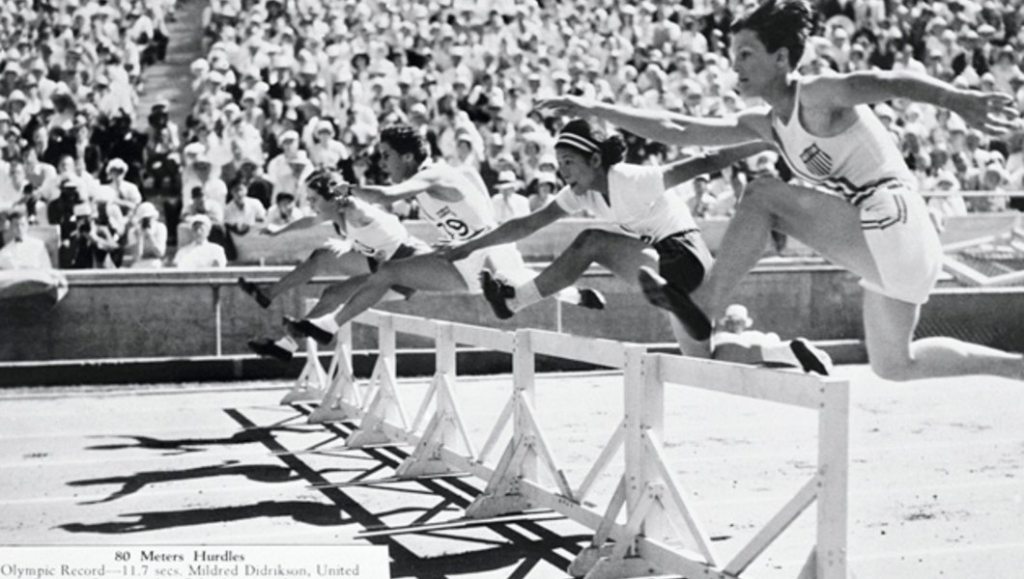 Women’s race at the 1932 Olympics. Source: http://www.olympichistory.info/
Women’s race at the 1932 Olympics. Source: http://www.olympichistory.info/
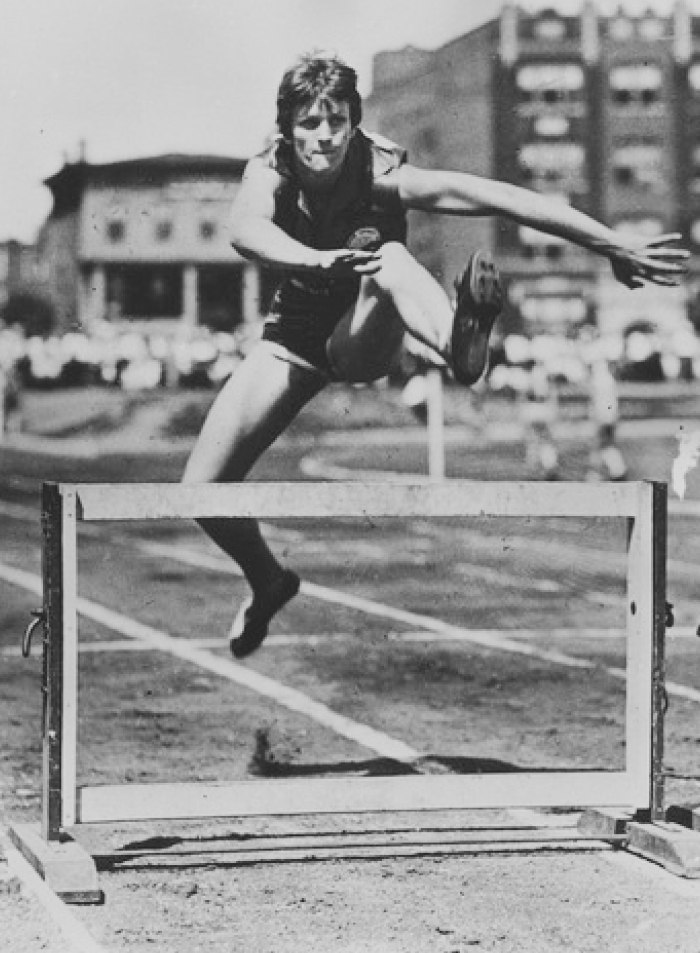 Babe Zaharias, the 1932 Olympic Champion. Source: https://366days.ru/
Babe Zaharias, the 1932 Olympic Champion. Source: https://366days.ru/
In 1968, the IAAF decided to replace the 80 m distance in women’s hurdling with a new one – 100 m, so the last record holder in this short distance is the Soviet hurdler, Vera Korsakova, who showed the result of 10.2 s.
In 1928, the First All-Union Games of the USSR were held. This largest competition played a huge role in promoting new athletics disciplines, including hurdling. It was decided to train Belarusian athletes in this sport. Thus, hurdling began to develop in Belarus from the 1930s.
Timofey Lunev is the star of Belarusian sports of the first post-war years. In 1944, he was noticed and trained by the wonderful coach, Boris Levinson. For six years (1947– 1953), the talented hurdler had been the winner in the 200 m distance among Soviet athletes. He improved the records of the USSR nine times, and broke the record of Europe. At the 1953 World Student Games in Budapest, he won a bronze medal at the distances of 110 m and 200 m.
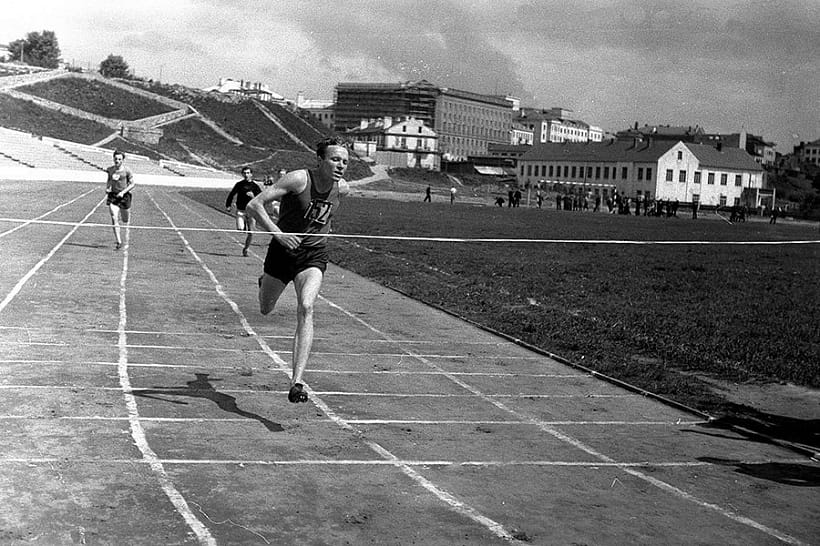 1Timofey Lunev at the Dinamo stadium track, 1951. Source: https://www.sb.by/
1Timofey Lunev at the Dinamo stadium track, 1951. Source: https://www.sb.by/
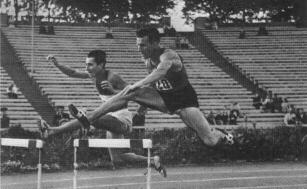 Rivalry on running tracks. Source: http://bfla.eu
Rivalry on running tracks. Source: http://bfla.eu
The legendary athlete repeatedly became the champion of the Soviet Union in all three racing disciplines with barriers (1947 – 200 m; 1948 – 110 m, 200 m and 400 m; 1949 – 200 m and 400 m; 1951 – 200 m). Timofey Lunev twice during 1948 improved the record of the BSSR in the 110m race (15.8 s and 14.7 s).
Anatoly Yulin, also a trainee of Boris Levinson, continued the glorious traditions of Belarusian hurdlers. He took the fourth place at the Olympic Games in 1952, and won a gold medal at the 1954 European Championship in Bern (he did not reach the world record of only 0.1 s). With a score of 50.5 he tops the top ten of the world's best athletes in the 400m race. As a member of the USSR national team, he participated in the 1956 Olympics and the 1958 European Championships.
In 1960, Viktor Balikhin from Brest set a republic record of 13.7 seconds in the 110 m race. In 1967, he became the champion of the Soviet Union, sensationally winning the race against ten-time USSR champion Anatoly Mikhailov.
In the 1970s, a native of Gomel Yevgeny Gavrilenko was among the best hurdlers in the world. He also successfully performed at sports competitions. The talented athlete is a repeated champion of the USSR (1972, 1974, 1075, 1976); Olympic bronze medalist (1976, Montreal) and European Championship (1974, Rome); Champion of the USSR Peoples’ Games (1975).
 Yevgeny Gavrilenko. Montreal 1976 Olimpic games. Source: https://www.mundodeportivo.com/
Yevgeny Gavrilenko. Montreal 1976 Olimpic games. Source: https://www.mundodeportivo.com/
Then the hurdler Viktor Myasnikov took the champion’s baton. He is the USSR champion among juniors, participant of the 20th and 21st Olympic Games, champion and silver medalist of European Indoor Championships, champion of the 6th USSR Peoples’ Spartakiad, winner of the USSR–USA match, 10-time USSR champion, 5-time USSR record holder.
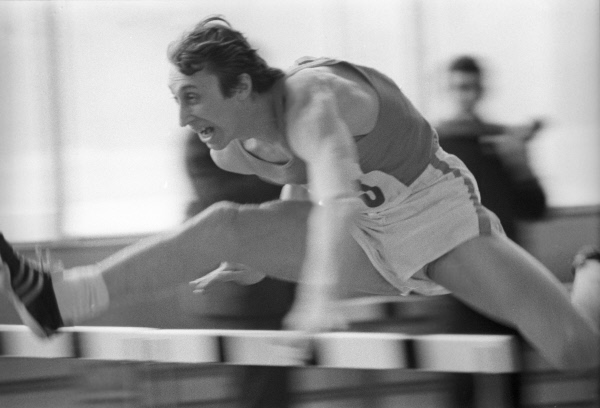 Ten-time USSR champion Viktor Myasnikov. Source: http://visualrian.ru/
Ten-time USSR champion Viktor Myasnikov. Source: http://visualrian.ru/
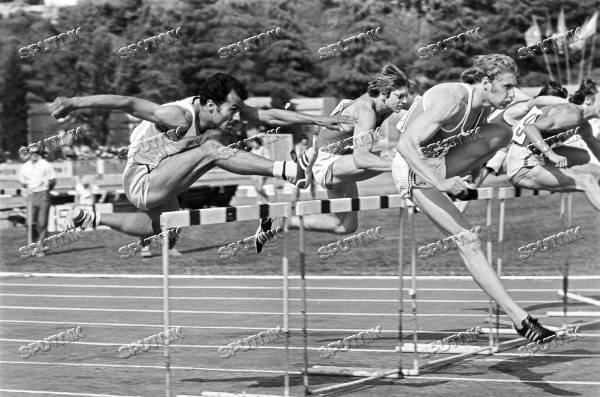 Viktor Myasnikov (in the foreground). Source: http://visualrian.ru/
Viktor Myasnikov (in the foreground). Source: http://visualrian.ru/
Alexander Vasilyev, the winner of the Druzhba-84 Competition in the 400m race, achieved high sports results. In 1985, the trainee of Anatoly Yulin set a new record for the BSSR and the USSR with a brilliant result: 47.92 seconds.
The success of Belarusian female athletes in the 80m race is less significant. Since 1968, in order to improve the results in women’s hurdling, a new distance is introduced – 100 m, in which T. Pogorelova set the first record (13.9 s).
Lidiya Okolo-Kulak (Yurkova), a student of the BSAA, had repeatedly improved the country's record in the 100m race from 1985 to 1990. In 1989, she won a silver medal at the World Student Games in Zagreb, a bronze medal at the European Championship, and became the Champion of the USSR.
Tatyana Kurochkina, also a trainee of Anatoly Yulin, in 1988 achieved successful results: she won a silver medal at the USSR Championship in the 400m race (55.37 seconds). During her sports career she was a finalist at the Olympic Games, a participant in the world championships, and many times winner of the European Cup in her best distance.
In 1988, Tatyana Ledovskaya, the three-time champion of the USSR youth championship and silver medalist of the World Student Games in Zagreb (1987), raced into the elite of the world-class hurdling.
The athlete was a trainee of Anatoly Baduev, who would be later recognized as the best European athletics coach.
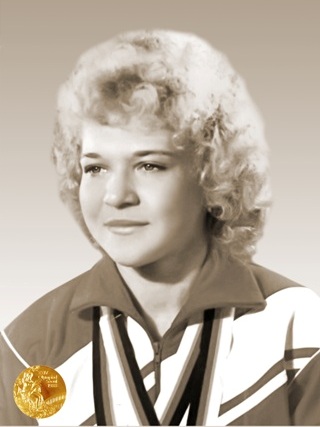 The Champion of the 1988 Olympics. Source: http://www.noc.by/
The Champion of the 1988 Olympics. Source: http://www.noc.by/
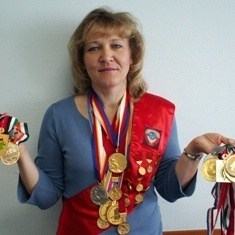 Tatyana Ledovskaya celebrating a jubilee 21.05.2016. Source: http://bfla.eu
Tatyana Ledovskaya celebrating a jubilee 21.05.2016. Source: http://bfla.eu
One of the most memorable events of the 1988 Olympiad in Seoul was the final race of the women's relay 4x400 m, where the US team was a clear contender for victory. At the first stage Tatyana Ledovskaya competed on behalf of the USSR. The outstanding Belarusian athlete was considered not only the strongest among hurdles, but also one of the best in the Soviet Union in the 400 m flat race. In this final, she won a champion title and set a new world record, which no one has yet succeeded to surpass: 3 min. 15.17 seconds.
In South Korea, she became a silver medalist of the same Olympics in the 400 m race. The photo finish determined the competitor’s microscopic advantage of one hundredth of a second, and the gold medal went to her.
In subsequent years, the legendary runner continued to replenish the list of sporting achievements in two cross-country disciplines. She was the Champion of the USSR in the 400 m race in 1988–1990; a silver medalist of the World Cup in 1989; the European Champion and silver medalist in the 4x400 m relay in 1990. In 1991, at the World Championships in Tokyo, she performed brilliantly, twice rising to the top step of the pedestal: in the 4x400 m relay and 400 m race with a new world achievement (53.11 s).
The Honored Master of Sports of the USSR Tatyana Ledovskaya was awarded the Order of Honor for outstanding achievements.
In 1991, the Belarusian Athletics Federation (BFLA) became part of the International Amateur Athletics Federation.
On March 22, 1991, the National Olympic Committee of the Republic of Belarus (NOC RB) was established.
In March 1991, BFLA was admitted to the International Association of Athletics Federations as an independent federation.
Since 1993, the Belarusian national team performs at official international competitions as an independent team.
Alina Talay is among the most talented athletes of Belarus at the present time. For eight years, she has been a trainee of Alexander Gutin, a coach from Orsha. The extraordinarily gifted girl constantly won the Republican competitions in the youth barrier sprint.
In 2008, at the World Junior Athletics Championships in Bydgoszcz (Poland), Alina Talay scored 13.31 seconds in the final. In 2009, the young athlete became a bronze medalist at the youth (U-23) European Championships in Kaunas (Lithuania), running a distance of 13.30 seconds.
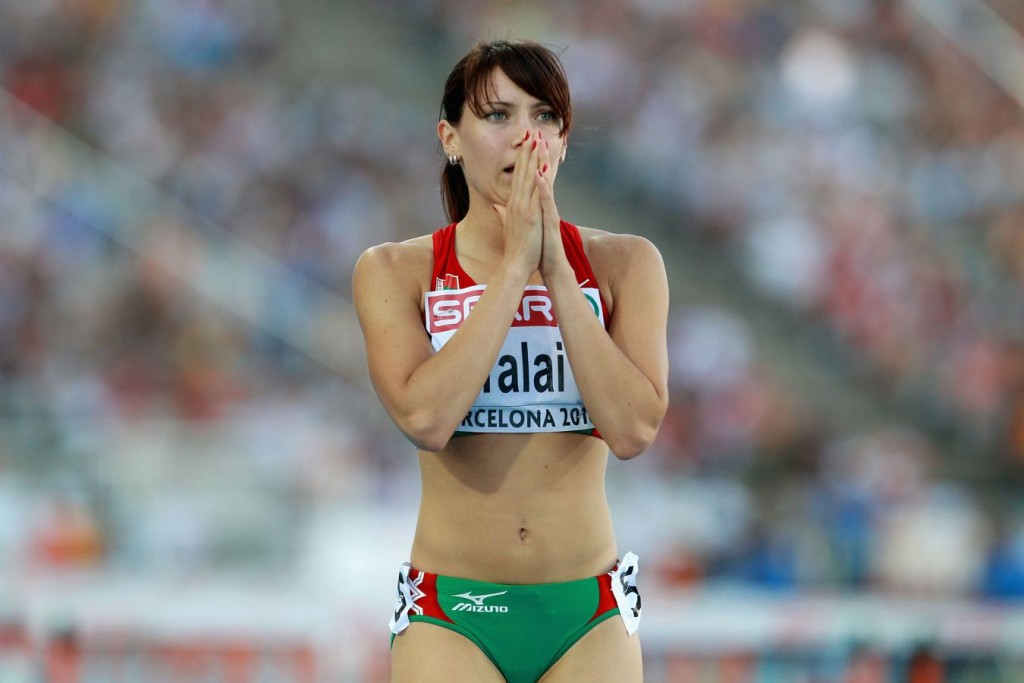 The beginning of sports career. Source: https://www.nastroy.net/
The beginning of sports career. Source: https://www.nastroy.net/
Since 2010, Alina Talay has been a member of the country's track and field team. At the 2011 Military World Games, she won the 100m race, and also took part in the U-23 European Athletics Championships in Ostrava (Czech Republic) and won the first gold medal in her professional sports career.
In 2012, the Belarusian runner twice raised to the pedestal. First, she took the 3rd place in Istanbul (Turkey) at the Winter World Championships in Athletics at a distance of 60 m, and then became the Vice-Champion of Europe in Helsinki (Finland) at a distance of 100 m. Being a debutant of the Olympic Games in London (2012), our athlete was able to get through to the semifinals. In 2013, Alina Talay won a silver medal at the World Summer Student Games (Kazan), and became the Vice-Champion with a national record (60 m, 7.94 s) at the World Championship in Gothenburg (Sweden).
Year 2015 was a success for the athlete. In Prague, she won the European Athletics Indoor Championship with a national record (60 m, 7.85 s). The previous record belonged to Lydia Yurkova (7.86 s) and held for 25 years. Then she became a bronze medalist at the world championship in Beijing (China), renewing the country's record again (100 m, 12.66 s).
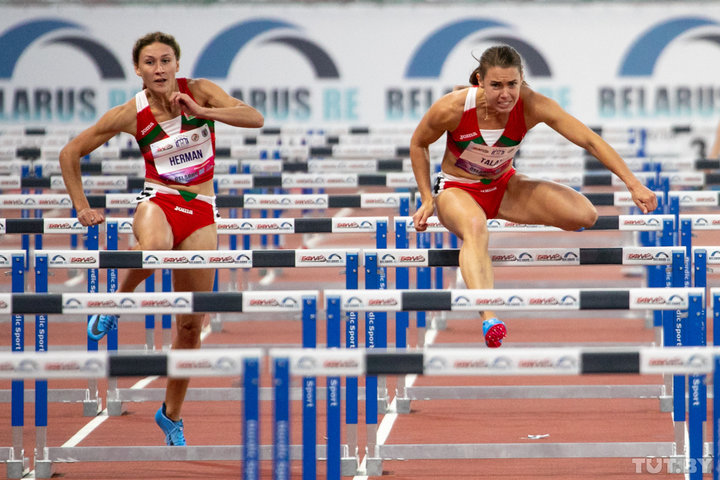 Alina Talay. Source: https://sport.tut.by/
Alina Talay. Source: https://sport.tut.by/
During the international tournament in Regensburg (Germany) in 2016, Alina Talay set a new record for Belarus in hurdling (100 m, 12.63 s). This record has become a huge success for the athlete. It is noteworthy that the previous achievement has not been updated since 1990. In the same year, the Belarusian athlete won a silver medal at the European Championships in Amsterdam (Netherlands). Alina Talay also participates in the Olympic Games in Rio de Janeiro.
At the 2017 European Athletics Indoor Championship in Belgrade (Serbia), Alina Talay became the Vice-Champion again (60 m, 7.92 s). The Belarusian Athletics Federation named her one of the best athletes of the country in 2017.
Performing at the international Liese Prokop Memorial competitions in St. Pölten (Austria) in 2018, the leader of the Belarusian track and field team rewrote the national record twice. In the preliminary race, she flew the distance in 12.61 seconds, and in the final she renewed her previous achievement (100 meters, 12.41 seconds). The result of Alina Talay was the seventh in Europe in the entire history of hurdling and was recognized as the best result among European runners since 1992.
Reaffirming her high skill, the outstanding athlete won two international tournaments during the year, in Manchester and Berlin.
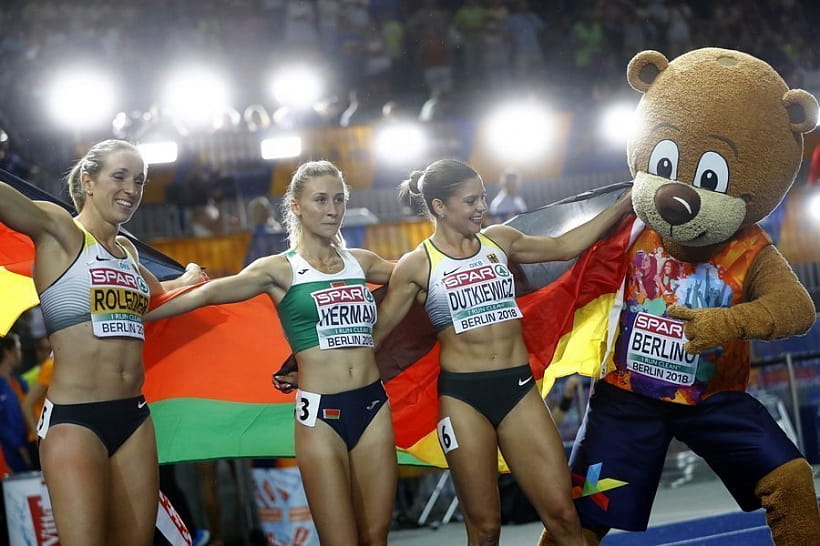 The golden finish. Source: https://www.sb.by/
The golden finish. Source: https://www.sb.by/
Elvira Herman is one of the best young athletes in the Belarusian athletics. She was a trainee of the coaches from Pinsk, Elena Verenich and Alexander Sinkevich, and first specialized in high jumps, but her talent was really revealed in hurdling. The first serious success for the 16-year-old athlete came in 2013. At the European Youth Olympic Festival (U-18), which was held in Utrecht (the Kingdom of the Netherlands), she won a bronze medal (100 m, 13.92 s).
After this festival, the athlete continued to hone her sports skills with coach Viktor Myasnikov at the Republican State School of Olympic Reserve. Her hard work and perseverance resulted in achieving high results on the running track.
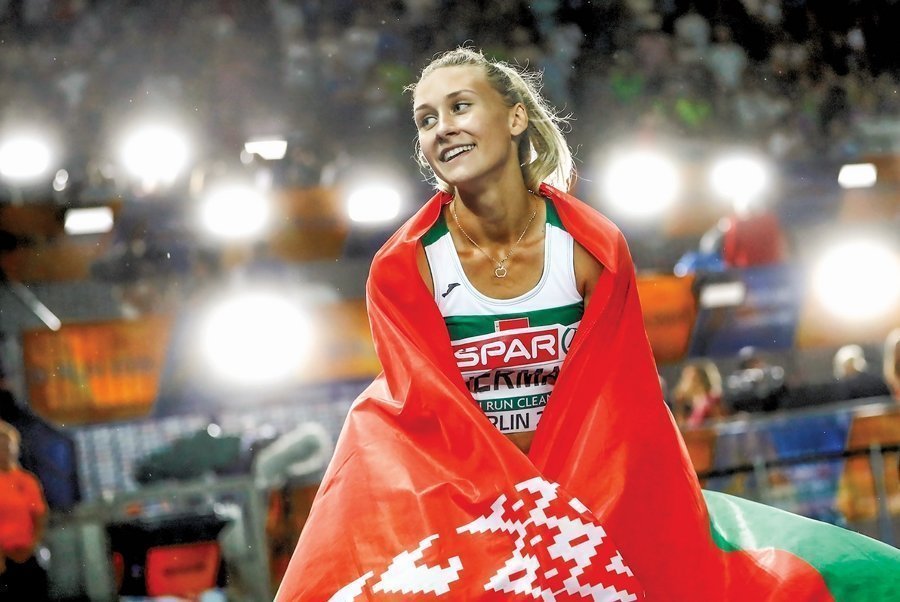 Elvira Herman is the champion again! Source: https://www.sb.by/
Elvira Herman is the champion again! Source: https://www.sb.by/
At the 2014 Summer Youth Olympic Games in Nanjing (China), Elvira Herman became a silver medalist (100 m, 13.38 s). In 2015, in Sweden, she won the main title of the Junior European Championship (U-20) with a new junior record of Belarus: 13.5 seconds. In 2016, at the World Junior Athletics Championships in Bydgoszcz (Poland), the Belarusian runner won with a score of 12.85 seconds.
In 2016, she was awarded a special prize "Belarusian Sports Olympus".
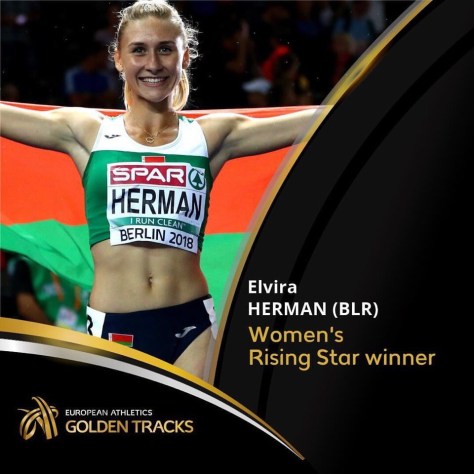 "The Rising Star 2018" by the IAAF. Source: http://www.noc.by/
"The Rising Star 2018" by the IAAF. Source: http://www.noc.by/
In 2017, at the Youth (U-23) European Championships (Bydgoszcz), Elvira Herman became the Vice-Champion of the Continent (100 m, 12.95 s). At the 28th World Student Games in Taipei (Taiwan), she again rose to the podium, winning a silver medal.
In 2018, Elvira Herman won the European Championship in Berlin (100 m, 12.67 s) and at the age of 21 became the youngest European champion in this discipline in the entire history of the continental forum. In the same year, in the city of Zamorin (Slovakia), the Belarusian runner won the competition, updating Belarus' youth record (U-23) on 100-meter hurdles: 12.64 seconds.
In October 2018, Elvira Herman became the first Belarusian athlete to win an award at the Golden Tracks award ceremony in Lausanne (Switzerland). Her fantastic diligence, dedication and excellent technical training helped Elvira Herman to become one of the most titled athletes in the Belarusian national team.
The Honored Coach of the USSR and the Republic of Belarus Viktor Myasnikov is currently considered one of the best coaches in our country.
 The teacher and his trainees. Source: http://bfla.eu
The teacher and his trainees. Source: http://bfla.eu
Today, he trains the talented athletes: Elvira Herman (2018 European Champion, world and European Champion among juniors, winner of the European Championship among youth, Champion of Belarus among youth, record holder of Europe among juniors); Vitaly Parakhonko (semi-finalist of the World Indoor Championships and the 2018 European Championship); Champions of Belarus Stanislav Dorogokupets and Maxim Graborenko; the promising hurdlers Victor Sinkovets, Ruslana Rashkovan and Svetlana Parakhonko.
During his coaching career, Viktor Nikolaevich has worked with Alina Talay, Maxim Lynsha, Evgenia Volodko, Alexander Linnik and other famous Belarusian sprinters.
The national team of the Republic of Belarus in high jump: http://bfla.eu/wp-content/uploads/2015/01/2019.pdf
High jump with an approach run is a way to overcome a vertical obstacle. It consists of several interconnected elements: approach run, take-off, flight over a bar and landing. The high jump requires athletes such qualities as jumping, agility, flexibility, and coordination. It refers to athletics and along with other disciplines composes the basis of this sport.
High jump is one of the most popular sports. For a long time jumps were performed both the place and with the run. Now jump competition in the height of the space is not carried out.
For many decades, they were constantly searching a special, more effective technique of jump.
There are several techniques of high jump: "gymnastic jump", "scissors", "eastern cut-off style ", "western roll", "straddle" and "Fosbury Flop".
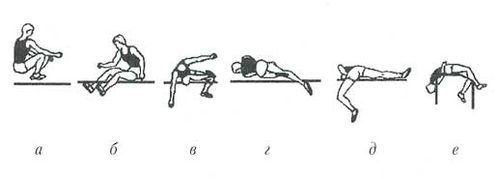 Evolution of high jump. Source: http://sportwiki.to
Evolution of high jump. Source: http://sportwiki.to
At the beginning of the 19th century funny jump over the stick was very popular. Athletes overcame the height with the so-called “gymnastic” method: direct approach run, crossed legs.
 Alma Richards competes in the high jump competition in 1911. Source: http://loveopium.ru
Alma Richards competes in the high jump competition in 1911. Source: http://loveopium.ru
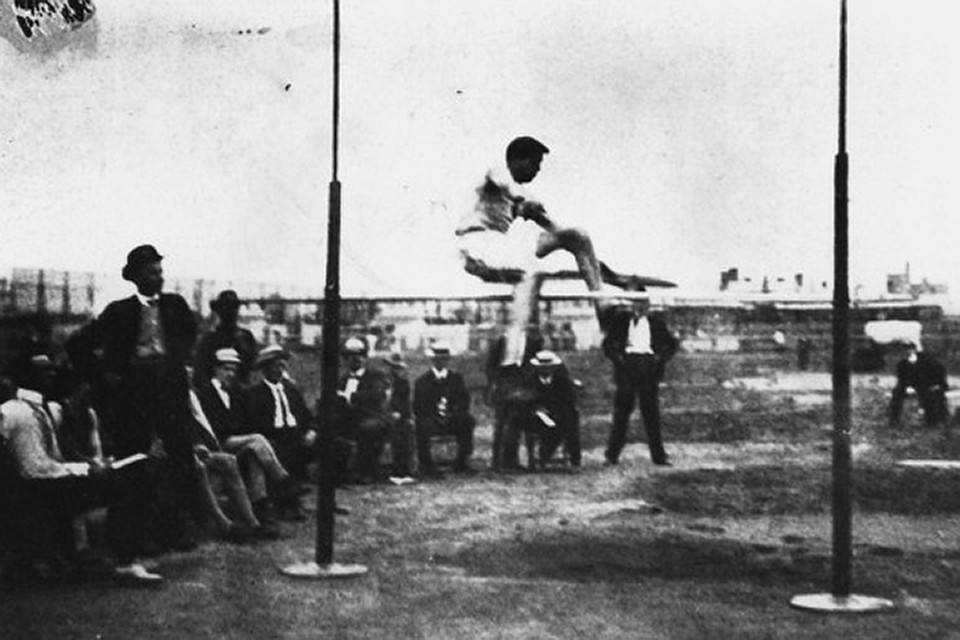 High jump. Source: https://www.kp.kg
High jump. Source: https://www.kp.kg
In the Chronicles of those years there are mentioned several names of athletes who stood out by their outstanding jumping ability. So, Karl Muller from Germany easily jumped over a height equal to his chin (unfortunately, his height is unknown).
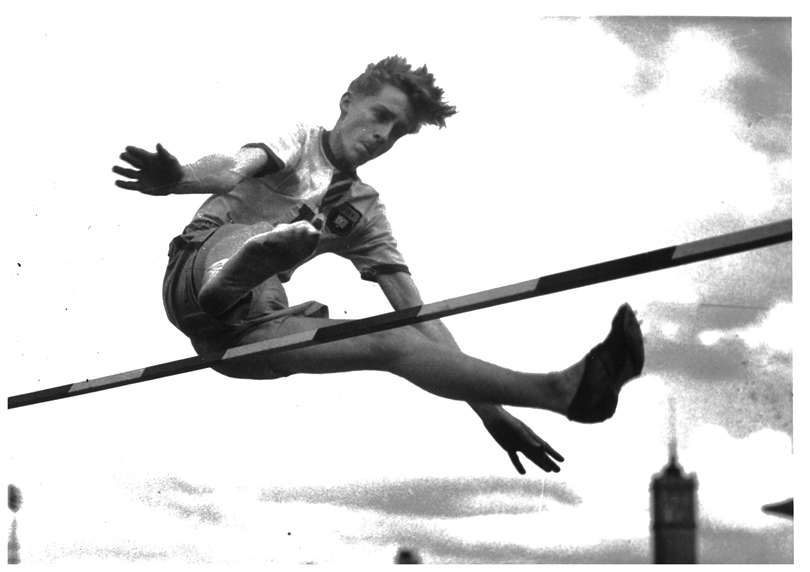 “Scissors” jump. Source: https://www.syl.ru
“Scissors” jump. Source: https://www.syl.ru
In 1859, considering that the “gymnastic” technique is irrational, an English student Robert Gooch showed a unique jump, imitating the movement of scissors. Using this method with a sharp run, he “stepped over” the bar at a height of 1 m 70 cm. Subsequently, this style was called “scissors”. Many athletes used it until 1937.
In 1864 the English athlete Robert Meich could jump on a grass field to the height of 167 cm.
In 1887 a student from the USA V. Page (his height was only 169 cm), using the “scissors” technique, set a phenomenal world record: he jumped to the height of 1 m 93 cm (24 cm above his head).
 “Scissors” technique. Source: https://studme.org
“Scissors” technique. Source: https://studme.org
In those years, American athletes specialized in several types of jumping. At the 1896 Olympics in Athens Ellery Clark became the champion not only in the high jump, but he had the best result in the long jump too.
At the 1900 Olympics his compatriot Irving Knot Baxter had no equal in jumps (both high jump and pole vault). He was ahead of the silver medalist by as much as 12 cm. The athlete became a three-time silver Olympic champion in standing jump disciplines (high jump, long jump, triple jump).
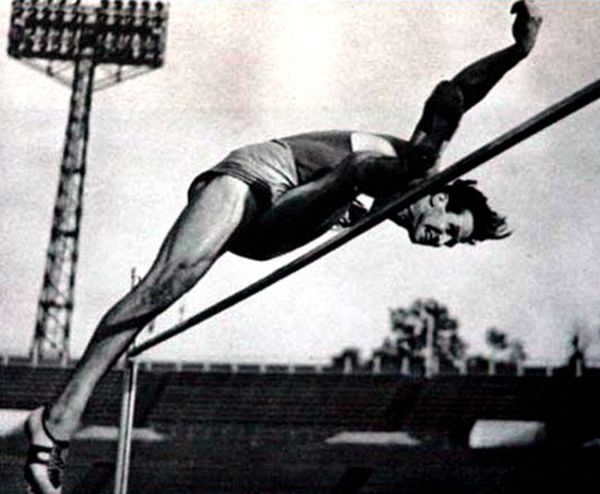 Michael Sweeny. Eastern cut-off style. Source: https://zen.yandex.ru
Michael Sweeny. Eastern cut-off style. Source: https://zen.yandex.ru
Due to the “eastern cut-off style” jumping technique, which replaced “scissors”, it became possible to bring the body over the bar closer to the horizontal position, which determined its greater efficiency.
Michael Sweeny is known as an innovator of the eastern cut-off high jump style. The athlete ran at a right angle to the bar and with a consistent, wavy movement carried body parts through the bar out and landed on a take-off foot (opposed to “stepping”).
 Eastern cut-off style. Source: https://studme.org
Eastern cut-off style. Source: https://studme.org
Due to this technique, Sweeney set a new world record − 1 m 97 cm, held for 17 years.
The American student George Horine invented the western roll technique. The athlete runs to the bar at an angle from the side of the take-off foot, pushes off, goes over the bar and lands on the same leg. By this way the jumper flies horizontally above the bar.
 Western roll technique. Source: https://studme.org
Western roll technique. Source: https://studme.org
A new method allowed the athlete to make the jump of dreams in 1912. He was the first in the world to overcome the two-meter height. This style went down in history as the “horine” style, and then began to be called the “roll” technique. For many years it was used as the main jump style, including by the Soviet high jumpers.
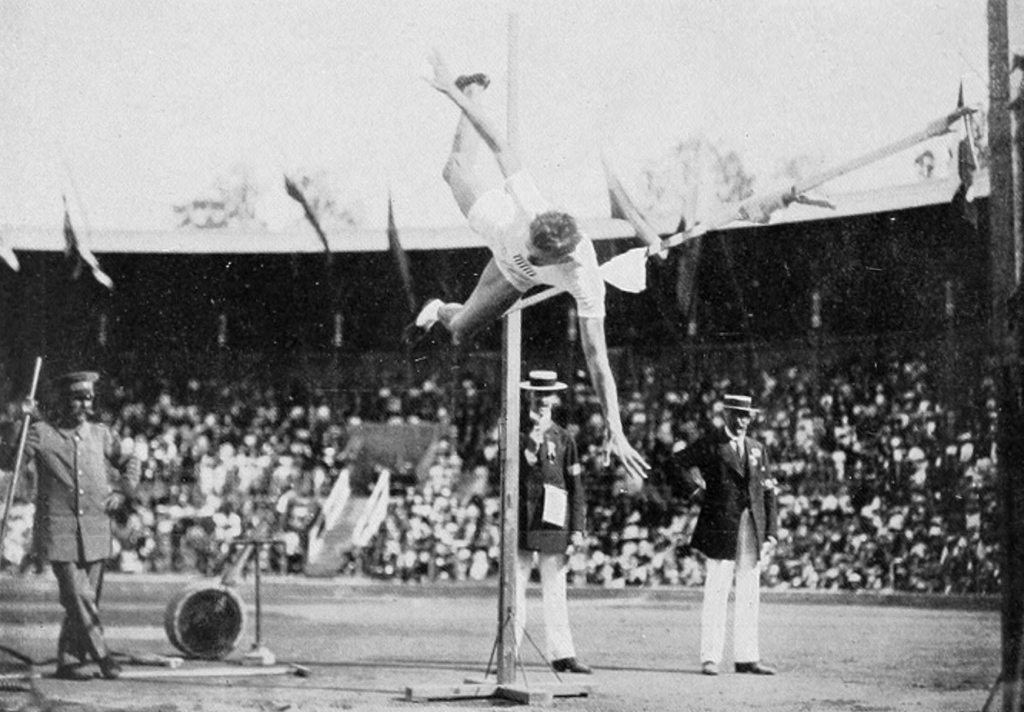 George Horine, western roll technique inventor, first in the world to overcome the two-meter height. Source: https://ecoprog.ru
George Horine, western roll technique inventor, first in the world to overcome the two-meter height. Source: https://ecoprog.ru
After the 1912 Olympics in Stockholm, the roll technique gained universal recognition. It was simple and efficient. Women begin to learn it too.
In the meantime, the world's strongest jumpers have already successfully mastered the straddle technique: the athlete jumps over the bar in a belly-down position due to a larger body rotation. Record David Albritton (USA) set the record of 207.6 cm in 1936, surpassed all previous methods of high jump.
 Straddle technique. Source: https://studme.org
Straddle technique. Source: https://studme.org
Finally, in 1941 the American athlete Lester Steers, using the straddle technique, renewed the world record, having jumped at a height of 211 cm. This style remained the main one until 1968.
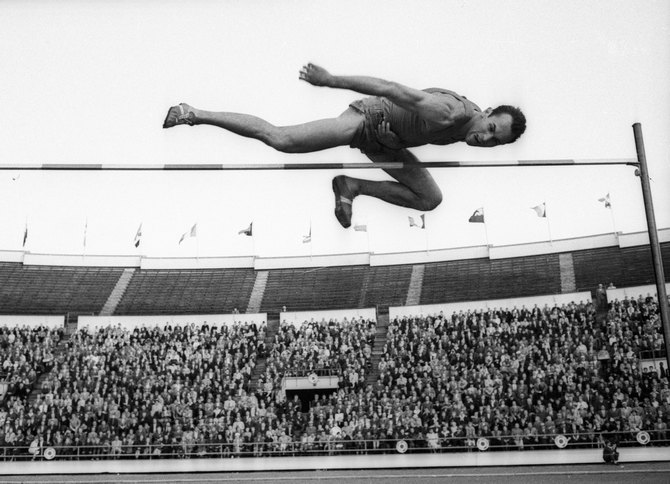 The era of victories and records by Valery Brumel. Source: https://rusatletik.ru
The era of victories and records by Valery Brumel. Source: https://rusatletik.ru
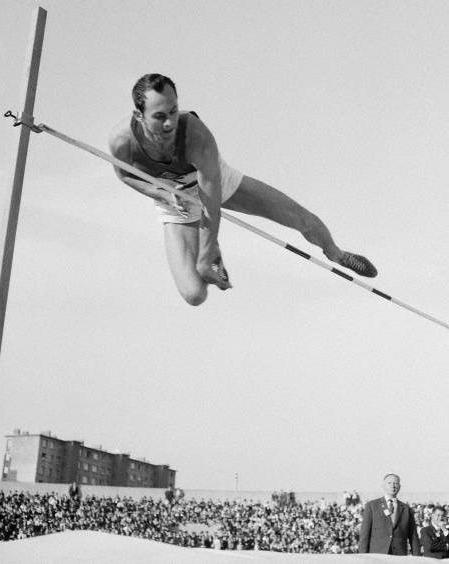 Record by record. Source: http://fb.ru
Record by record. Source: http://fb.ru
Olympic champions Robert Shavlakadze (216 cm in 1960), Valery Brumel (218 cm in 1964) and Yuri Tarmak –(223 cm in 1972) became prominent representatives of this style in the Soviet Union.
The last "straddle king" was the fantastically talented Vladimir Yashchenko, who jumped at 235 cm in 1978.
 V. Yashchenko, successor of the legendary Brumel. Source: https://operkor.wordpress.com
V. Yashchenko, successor of the legendary Brumel. Source: https://operkor.wordpress.com
Till 1968 high jumps were developed from a straight body to bend.
At 1968 Olympics the winner of the competition, American Dick Fosbury, presented an unusual way of jumping, having set a new Olympic record (2.24 m), that became the milestone in the development of this sport.
In such a way the fairy tale about a boy who proved that the impossible is possible appeared in the history of sports. At a young age Richard Douglas (Dick) Fosbury was the weakest jumper in his school. In the school team he could not master any styles.
One day having seen Valery Brumel’s jump on TV, he firmly decided to become the best, just like his idol. Fosbury began searching for his unique technique. Despite the disagreement of coaches, who assured that “smart people have already invented everything before you”, despite his parents, talking about wasting time, he has created his own jump style, which was ironically called “flop”. After the 1968 Olympics it was named after the winner: high jump in the “Fosbury Flop” technique.
 “Fosbury Flop” technique. Source: https://studme.org
“Fosbury Flop” technique. Source: https://studme.org
The main advantage of the “Fosbury Flop” technique is a more efficient way of approach. The absolute speed of the takeoff, as the nature of the increase of the pace of steps in its final part are critically important. Practically all modern high jumpers use the “Fosbury Flop” technique.
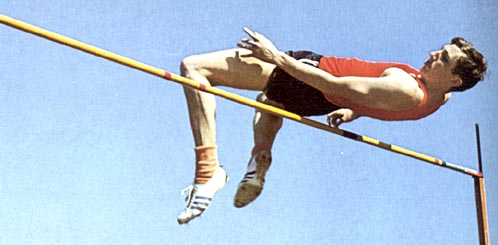 “Fosbury Flop” style. Source: https://chereek.wordpress.com
“Fosbury Flop” style. Source: https://chereek.wordpress.com
 Dick Fosbury. Source: http://athletics-sport.info
Dick Fosbury. Source: http://athletics-sport.info
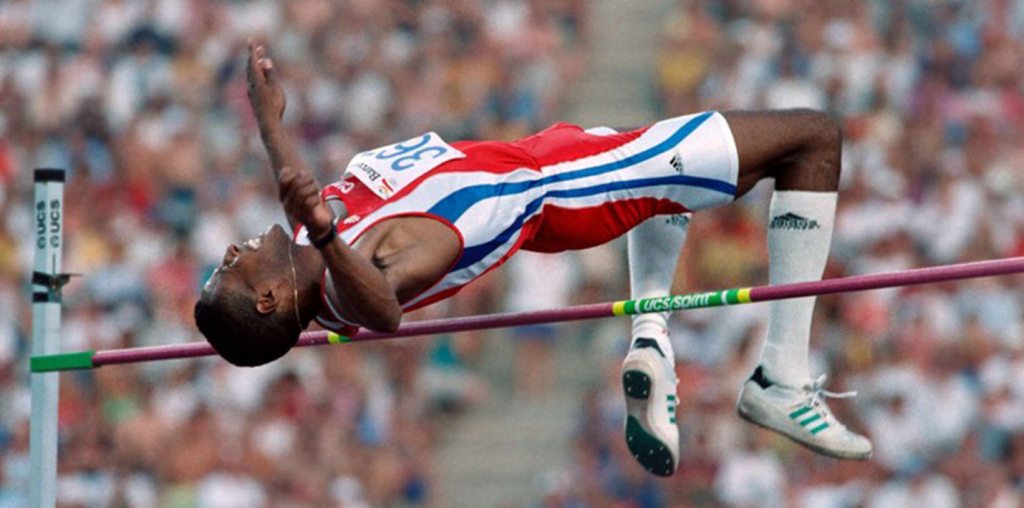 Javier Sotomayor. Source: https://betslive.ru
Javier Sotomayor. Source: https://betslive.ru
After the end of his sports career, Fosbury made another gift to the sports world. He developed new spikes for high jumps: he invented the modern location of the spikes on the heel.
At present time rivalry in this sport is so great that, the world record could be broken soon: the last record was set by the famous Cuban jumper Javier Sotomayor (245 cm) in 1993.
In 1913, the first competitions where athletes showed results in jumps: 126 cm (standing high jump), 150 cm (running high jump).
In 1924–1925 friendly competitions in high jumps with a running start were held on the sports ground “Profintern”.
The achievements of the first BSSR male champions, Ivan Lynkin (165 cm in 1928) and Alexander Sheybak (170 cm in 1928) were relatively modest.
In 1935 Viktor Gankevich, who repeatedly jumped at 180 cm, made an attempt to improve the record of the USSR (185 cm), but failed.
In 1938 Nikolai Sokolov made the republic's record at a height of 182 cm.
In 1953 Vasily Misyuk, using the “scissors” style, showed a record result of 184 cm.
In 1958 Roman Bulygin significantly improves this result due to the roll style (197 cm). In 1958 he was the first in Belarus to jump 200 cm (in closed premise).
G. Gogoberidze, being a member of the Belarusian team, in 1959–1962, made the republic record − 205 cm.
In 1965 Rodion Krasheninnikov repeated this result, and then improved the highest achievement of Belarus for closed premises up to 206 cm.
From 1968 to 1970 Alexey Kaskov changed the republic's record four times and brought it up to 213 cm.
Then, during three years, the Vitebsk resident Leonid Knirov (215 cm in 1972) and Nikolai Savkin from Grodno (216 cm in 1973, 217 cm in 1974) improved national records.
The golden age of high jump in the BSSR began in the years of the work in Minsk (1972–1994) of a wonderful coaching couple, Honored Coaches of the USSR Pavel Goikhman and Elizaveta Sosina. Legends of world sports have grown a number of outstanding athletes.
 Elizaveta Sosina and Pavel Goikhman. Source: https://www.klbviktoria.com
Elizaveta Sosina and Pavel Goikhman. Source: https://www.klbviktoria.com
Thus, the four-time European record holder, seven-time USSR champion Alexander Grigoriev, using his version of the Fosbury Flop style, he was the second in the world to take a height of 230 cm in 1977, setting a record of the USSR and the BSSR and improving the Valery Brumel's record, which lasted 15 years.
Jumper from Vitebsk Grigory Marzinovich (231 cm in 1987) continued the winning trend. The winner of the 1988 Paralympics in Seoul, Oleg Shepel became the first champion in the history of the USSR.
 Alexander Grigoriev at a height of 230 cm. Source: http://visualrian.ru
Alexander Grigoriev at a height of 230 cm. Source: http://visualrian.ru
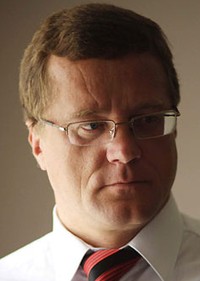 Oleg Shepel. Source: http://www.olympic-champions.ru
Oleg Shepel. Source: http://www.olympic-champions.ru
In 1991 the Belarusian Athletics Federation (BAF) became part of the International Amateur Athletics Federation.
On March 22, 1991 the National Olympic Committee of the Republic of Belarus (NOC RB) was established.
In March 1991 the BAF was admitted to the International Association of Athletics Federations as an independent federation.
Since 1993 the Belarusian national team performs as an independent team at the official international competitions.
Until 1993 the best trainees of Pavel Goykhman and Elizaveta Sosina entered the USSR and CIS national teams in high jumps. They continued to make happy Belarusian fans in the years when Belarus became a sovereign country. The family coaching duet has done a lot for the development of high jumps in Belarus. In 1993 their last Belarusian trainee Andrei Sankovich established a higher national record, 234 cm, which lasted a quarter of a century.
Since 1996 high jumps competition for Elizaveta Sosina prizes have been held in Belarus every year. Competitions are organized by trainees of outstanding trainers. (http://bfla.eu/?p=12420)
 Poster of the competition, 2016. Source: http://bfla.eu
Poster of the competition, 2016. Source: http://bfla.eu
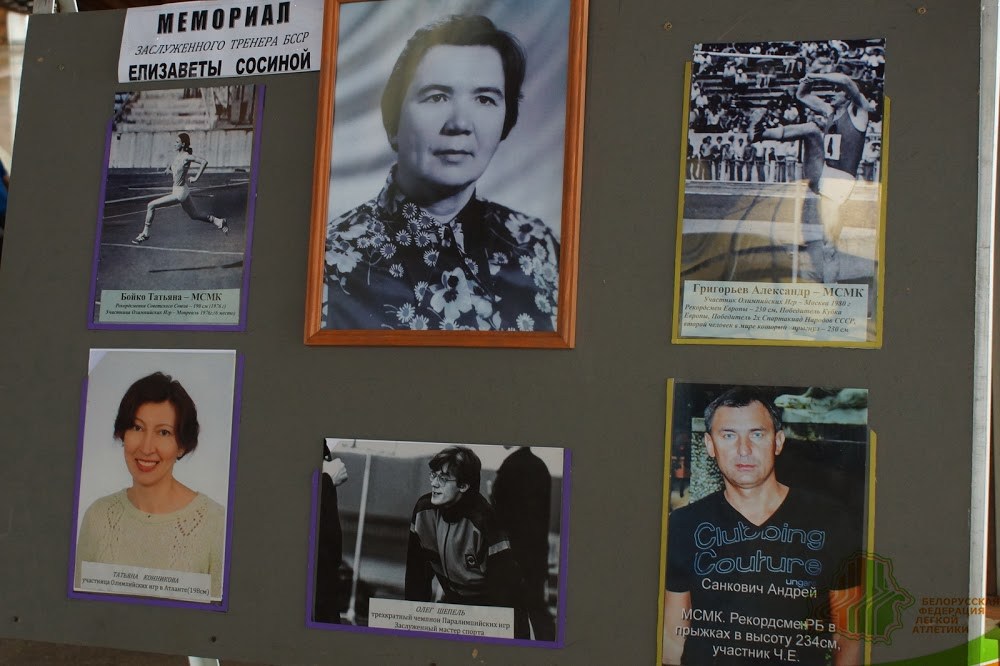 Memorial for Elizaveta Sosina, 2018. Source: http://bfla.eu
Memorial for Elizaveta Sosina, 2018. Source: http://bfla.eu
After a relatively short pause talented athletes reappeared, who, competing with each other, show serious results now.
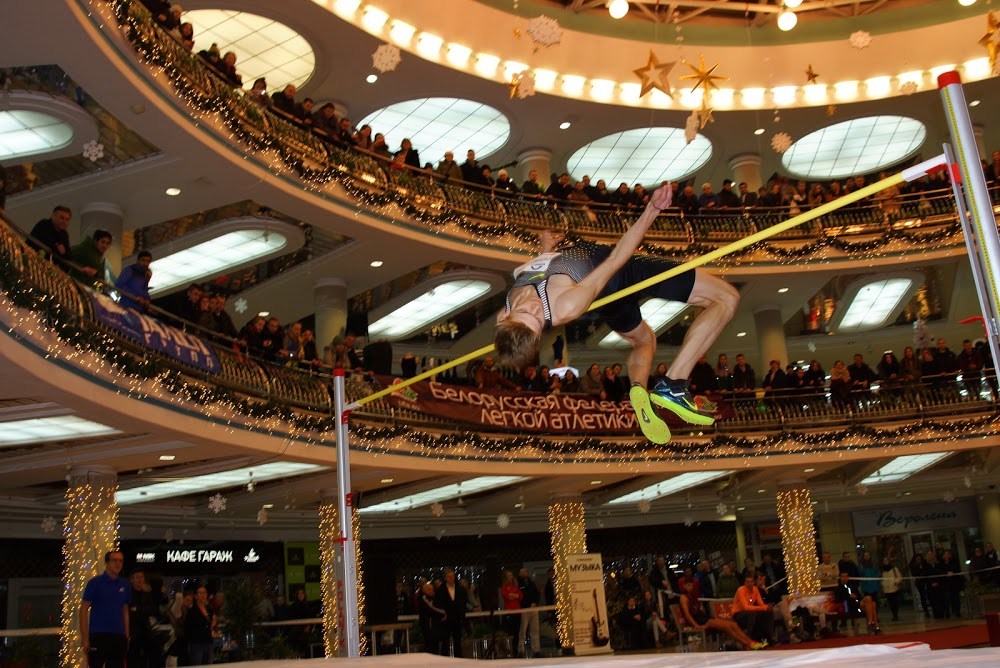 Pavel Seliverstov competes in the “Stolitsa” mall. Source: http://bfla.eu
Pavel Seliverstov competes in the “Stolitsa” mall. Source: http://bfla.eu
The Valentin Kurdyuk’s trainees made significant achievements: Andrey Churilo, junior world champion in 2012; 2017 European Championships bronze medalist Pavel Seliverstov, as well as youth team leaders Artem Naumovich, Pavel Kypra, Alexey Urbanovich and Igor Sinyak.
In February 2017 Pavel Seliverstov set his personal record (230 cm) at the 3rd stage of the IAAF World Indoor Tour in Karlsruhe (Germany). That year the athlete confirmed his leadership in the world ranking among high jumpers.
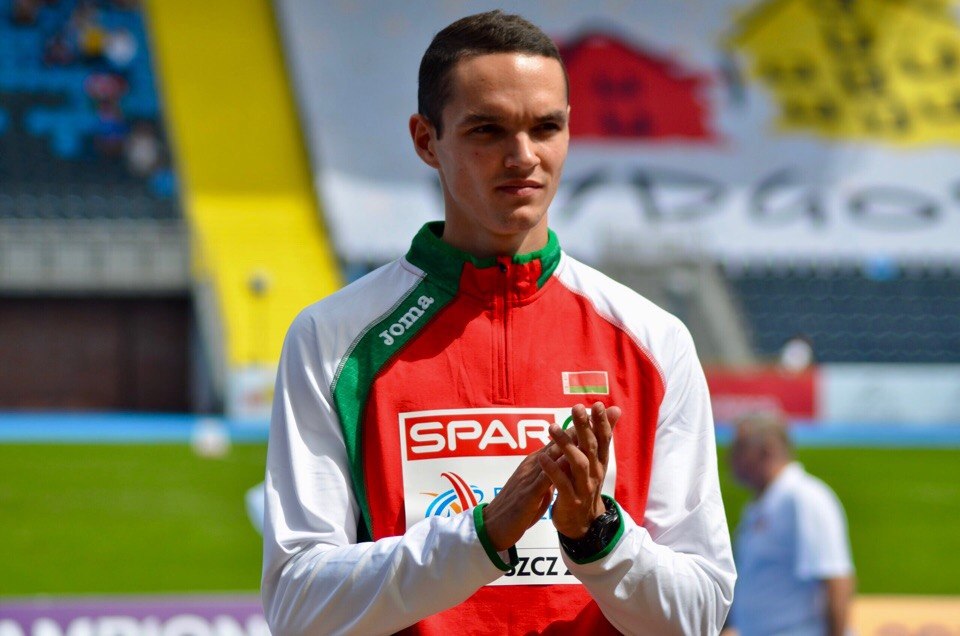 Dmitry Nabokov, new record holder of the Republic of Belarus. Source: http://www.ctv.by
Dmitry Nabokov, new record holder of the Republic of Belarus. Source: http://www.ctv.by
The talented athlete Dmitry Nabokov perfectly performed in the youth category, becoming the silver medalist of the 2015 World Junior Championships and the 2017 European youth champion.
Mogilev jumper, the Honored Coach of the Republic of Belarus Vladimir Fomichyov’s trainee continued to make us happy in the past season. In May 2018, at the Republican Universiade in Brest, he renewed the Andrei Sankovich’s national record, set 25 years ago, by 2 cm. Now a new record on open stadiums is 236 cm.
Vitebsk jumper Maxim Nedasekau has performed very well in recent years. In 2017 in Grosseto (Italy), he won the European Junior Championship and beat the junior 40-year-old record of the continent. A year later the Belarusian athlete won the silver medal at the European Adult Championship.
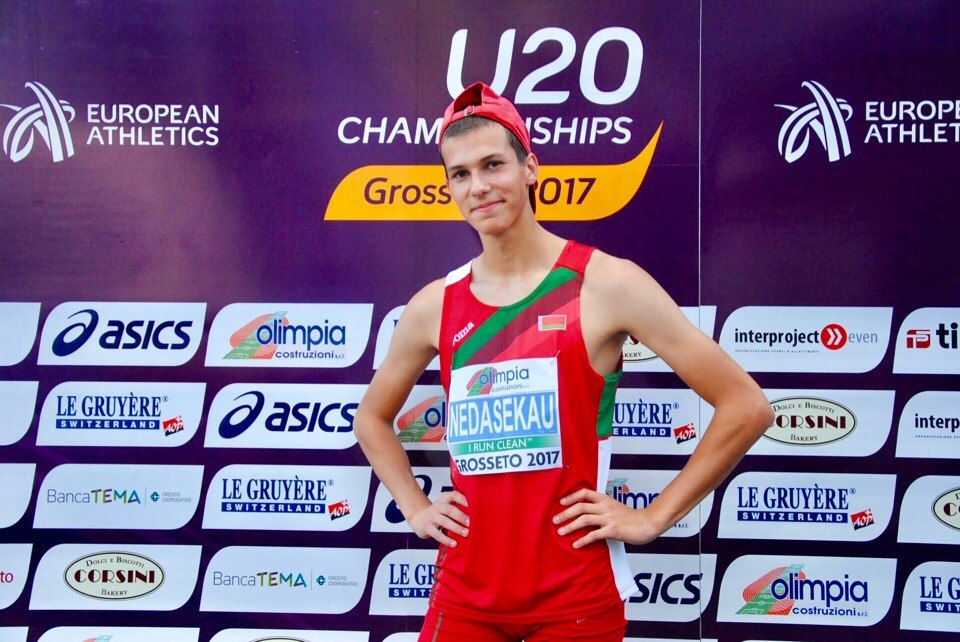 Maxim Nedasekau, European Champion. Sourse: http://www.ctv.by
Maxim Nedasekau, European Champion. Sourse: http://www.ctv.by
At the IAAF Continental Cup, the Belarusian jumper finished the competition with a bronze medal. During the year, he repeatedly became the winner of prestigious international competitions. He had a great season in 2018 and by his results proved that he has the right to be one of the best athletes in the world.
Training under the guidance of Tatyana Nareiko and Vladimir Pologov, Maxim Nedasekau constantly improves his athletic performance. In January 2019, he was recognized as the best athlete of the country following the results of the past season. The titled athlete continues to make happy his fans: at the stage of the Diamond League in Shanghai on May 18, 2019, Maxim Nedasekau showed the second result.
 Maxim Nedasekau, European Athletics Association nominee. Source: http://bfla.eu
Maxim Nedasekau, European Athletics Association nominee. Source: http://bfla.eu
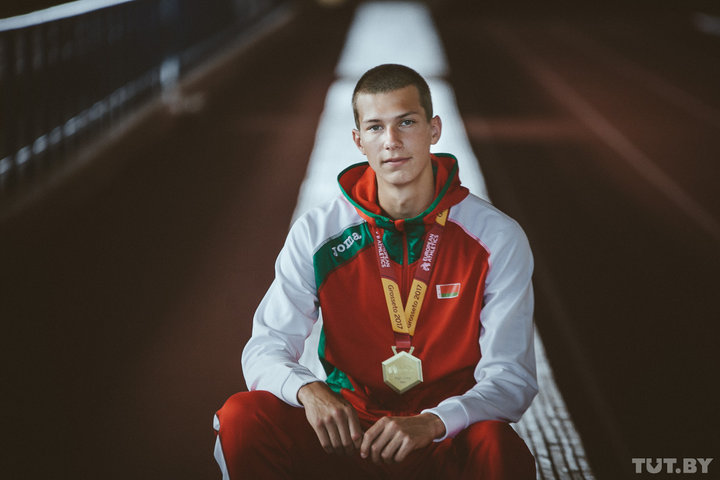 Maxim Nedasekau, European Athletics Association nominee. Source: https://sport.tut.by
Maxim Nedasekau, European Athletics Association nominee. Source: https://sport.tut.by
High jumps are a clash of characters and a psychological struggle of athletes. The winner is the one who can maximize their inner potential on a particular competitive day. In this sector, it is already ordinary to wait for surprises, having regard to the star and titled entry list. First, the rivalry between Maxim Nedasekau and Dmitry Nabokov is always some vivid and emotional spectacle. Secondly, the potential of Andrei Skobeiko (recovering from injury) is not forgotten, and the new heights performed by this athlete are only a question of time. And finally, Pavel Seliverstov also does not intend to surrender in this struggle.
Long jump is the “horizontal jump” for distance. It’s one of the technical types of athletics. It consists of several interconnected elements: a fast run-up, powerful takeoff, balancing action in the air and landing. Athletes combine jumping ability, good sprinting performance and coordination of movements.
Long jumps were popular in ancient Greece and were included in the Olympic Games programme, but the technique of the ancient jump was fundamentally different from the modern one. While performing the jump, the ancient Greek athletes held a special load in their hands − halteres (up to 4.5 kg), which was thrown back before landing, in order to increase the distance of the jump.
 Jumps with halteres. Source: http://www.i-kiss.ru
Jumps with halteres. Source: http://www.i-kiss.ru
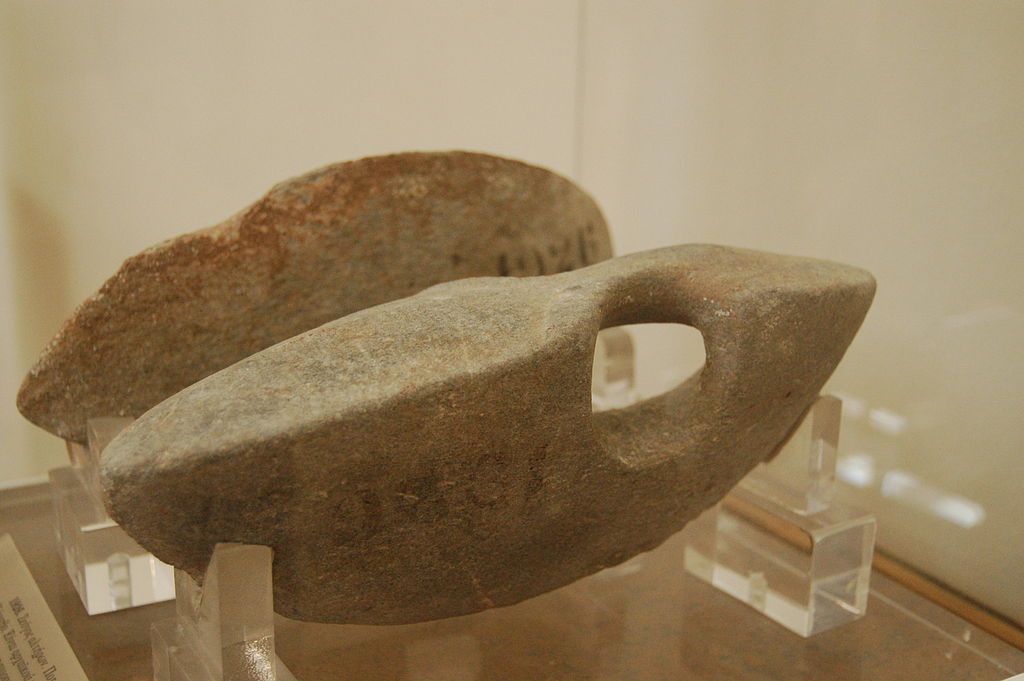 Halteres. Source: https://hyperleap.com
Halteres. Source: https://hyperleap.com
At the beginning of the revival of this sport at the end of the 19th century, track and field jump disciplines were becoming popular. The new technique of long jumps was developed mainly by UK and US athletes.
In 1860 this sport was included in the programme of the annual "Big Games" at Oxford University in England.
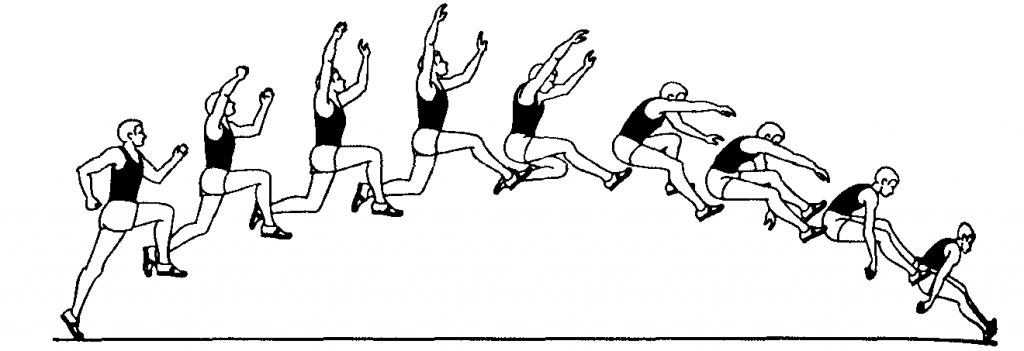 Squat jump. Source: https://pandia.ru
Squat jump. Source: https://pandia.ru
In 1896 at the first modern Olympic Games in Athens, there were long jump competitions, including running and standing jumps. At the present time standing long jumps are mainly used just for trainings. The exception is for Norway, the only country where standing long jumps have become a national sport.
 Standing long squat jump. Source: https://gto-normativy.ru
Standing long squat jump. Source: https://gto-normativy.ru
There are 3 types of technique of running long jumps: "squat jump" (or “stride jump”), the "hitch-kick" and the "hang style".
The squat jump is the easiest style, it was used in competitions until the end of the 19th century, but lost popularity in the next century. The stride jump is the simplest technique of jumping.
The rapid development of this type of athletics came at the beginning of the 20th century. The three-year rivalry between two prominent American athletes, Myer Prinstein and Alvin Kraenzlein, gave a push to the improvement of the long jump techniques. Each of them tried to take revenge after losing his opponent, updating the records of the continent.
As a result, Alvin Kraenzlein won the Olympic gold in 1900 in Paris and became the only four-time Olympic champion who managed to win 4 gold medals in individual disciplines at the same games.
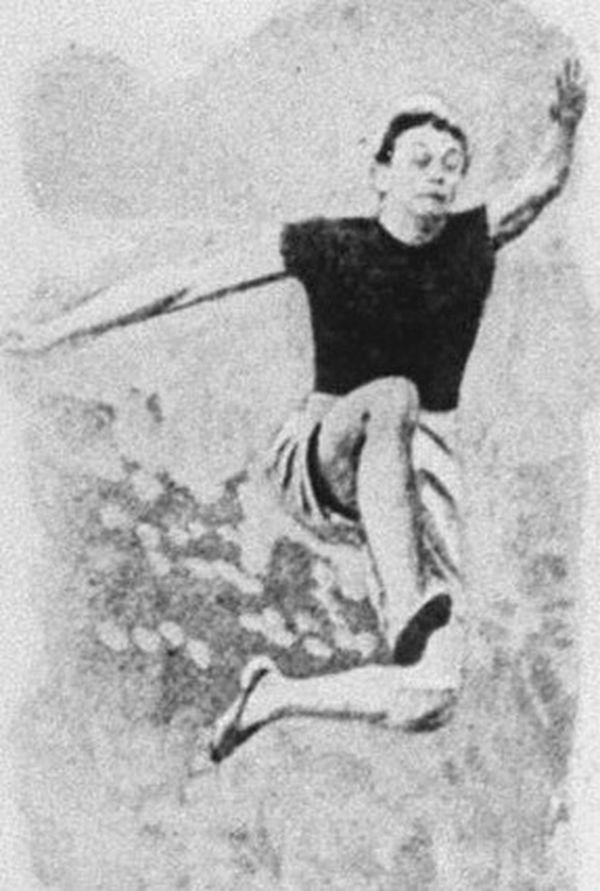 Alvin Kraenzlein is setting record. Source: https://rusatletik.ru
Alvin Kraenzlein is setting record. Source: https://rusatletik.ru
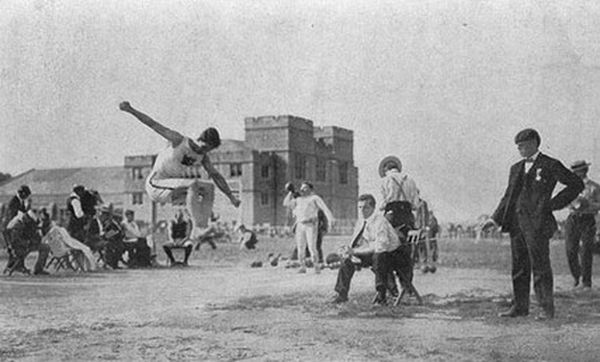 Myer Prinstein (735 см in 1904). Source: https://rusatletik.ru
Myer Prinstein (735 см in 1904). Source: https://rusatletik.ru
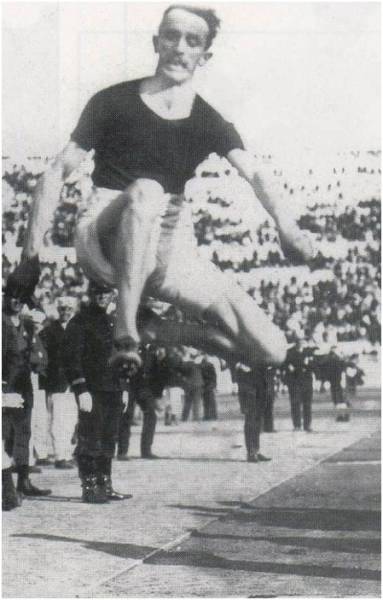 Peter O'Connor, multiple champion of Ireland. Source: http://www.i-kiss.ru
Peter O'Connor, multiple champion of Ireland. Source: http://www.i-kiss.ru
In 1904 Myer Prinstein entered sports history as the only athlete who managed to win in two disciplines in the same games: long jump with a world record of 7.50 m and triple jump.
In 1901 the Irish athlete Peter O'Connor, multiple champion of his country in all jumping disciplines, made the jump at a distance of 7.61 m. This record has been unbeaten for 20 years.
In 1920 the Finnish jumper Vilho Tuulos demonstrated for the first time a new technique of long jump, the hang style, which requires a good fitness and coordination. A flight jumper sags the body in the lower back and, as it were, pauses before landing.
 Hang style jumps. Source: https://m.studme.org
Hang style jumps. Source: https://m.studme.org
Among women the first record holder in the long jump was the Japanese Hitomi Kinue. The champion of the 2nd World Women's Games, held in Gothenburg in 1926, set a world record (5.98 m).
 Kinue Hitomi. Source: https://www.peoplelife.ru
Kinue Hitomi. Source: https://www.peoplelife.ru
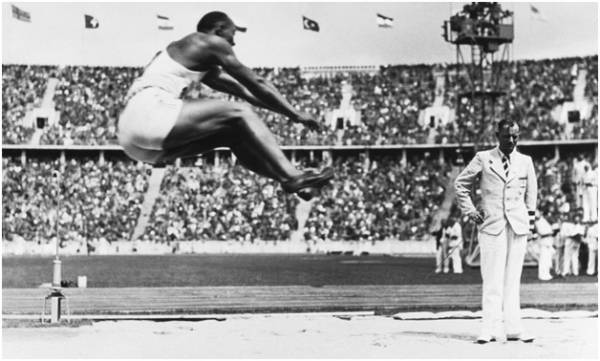 Jesse Owens, USAб 1935. Source: http://www.i-kiss.ru
Jesse Owens, USAб 1935. Source: http://www.i-kiss.ru
 Jesse Owens at 1936 Summer Olympics in Berlin. Source: https://humaninside.ru
Jesse Owens at 1936 Summer Olympics in Berlin. Source: https://humaninside.ru
In 1935, James Cleveland "Jesse" Owens, the future four-time Olympic champion, was the first to cross the eight-meter line (8.13 m). He set the world record which was unbeaten until 1960.
In 1939 the German jumper Schulz crossed the six-meter mark (6.12 m).
In the 1930s – 1940s the modern version of the long jump, the hitch-kick jump, came into the common use. An athlete continues to run in flight taking several steps (1.5–3.5) with his feet through the air. It is considered the most difficult technique that requires high speed-strength qualities. This style was demonstrated for the first time in 1898 by the outstanding athlete Myer Prinstein.
 The hitch-kick jump. Source: https://m.studme.org
The hitch-kick jump. Source: https://m.studme.org
In 1948 the long jumps were included to the programme of the modern Olympic Games for women.
In 1965 the world record set by American Ralph Boston was 8.35 m. Two years later Soviet athlete Igor Ter-Ovanesyan repeated it. Over the years these athletes were the main rivals, but they were friends in life.
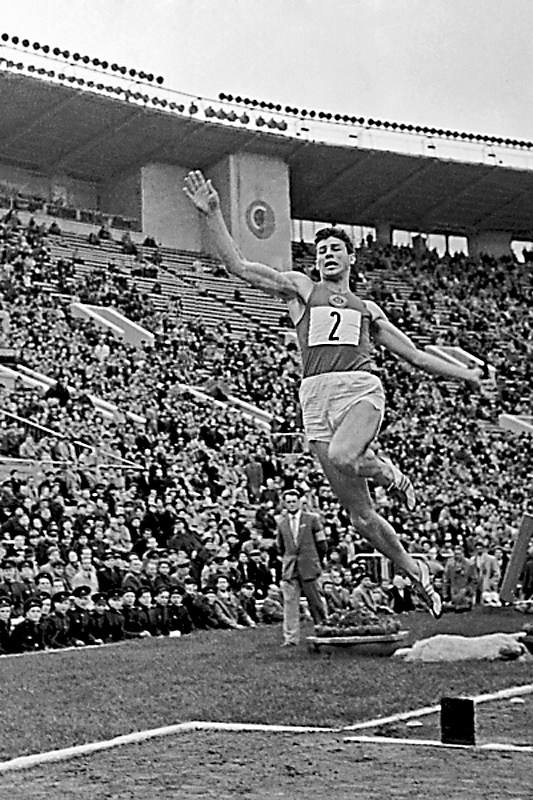 Igor Ter-Ovanesyan, 1967. Source: http://press.sportedu.ru
Igor Ter-Ovanesyan, 1967. Source: http://press.sportedu.ru
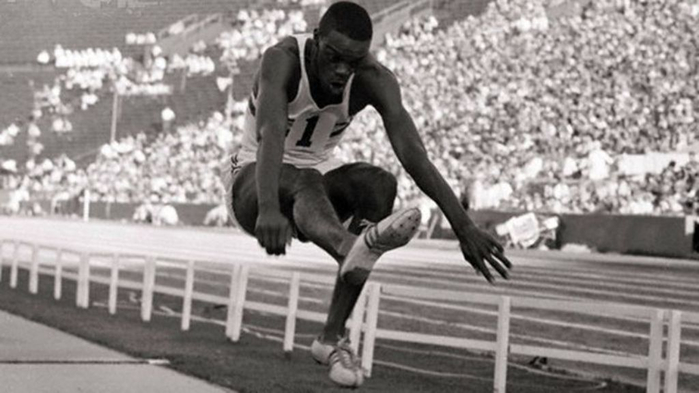 Ralph Boston (USA), 1965. Source: https://www.liveinternet.ru
Ralph Boston (USA), 1965. Source: https://www.liveinternet.ru
 Igor Ter-Ovanesyan and Ralph Boston. Source: http://sport-calendar.ru
Igor Ter-Ovanesyan and Ralph Boston. Source: http://sport-calendar.ru
In 1968 in Mexico City, the legendary Robert “Bob” Beamon improved the world record of hitch-kick jumping on 55 cm. The American athlete flew 8.90 meters in his first attempt. It is not surprising that Bob Beamon’s fantastic record was immediately called “leap into the 21st century”. The record lasted for 23 years.
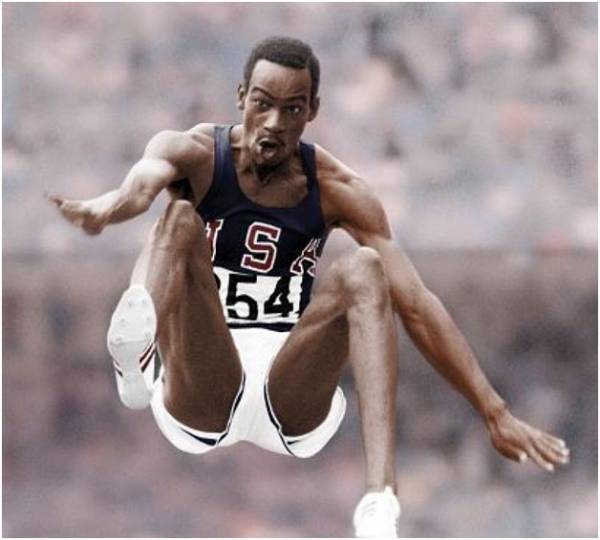 Robert “Bob” Beamon jumps into the 21st century. Source: http://www.i-kiss.ru
Robert “Bob” Beamon jumps into the 21st century. Source: http://www.i-kiss.ru
In 1978 Vilnius athlete Vilgemina Bardauskienė set a world record at the All-Union Competitions in Chisinau and became the first woman in the world to take the 7-meter mark. After 10 days at the European Championships in Prague in qualifying she improved again the world record by jumping to 7.09 m.
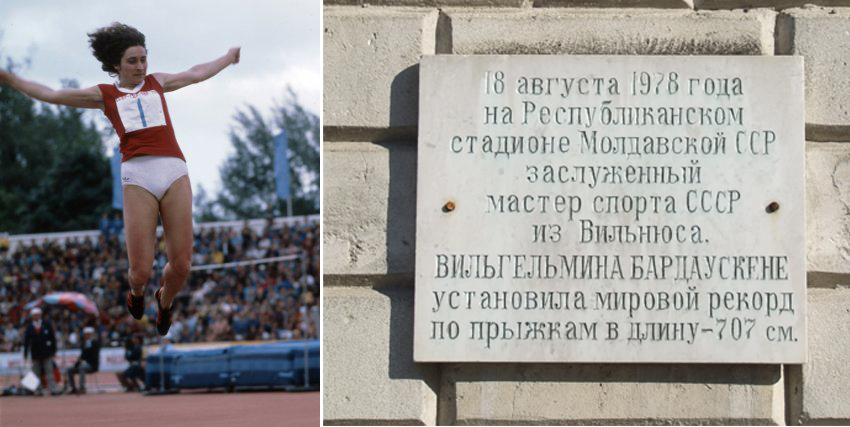 Chisinau, Republican Stadium. Memorial Tablet. Source: http://moimir.org
Chisinau, Republican Stadium. Memorial Tablet. Source: http://moimir.org
In 1983 the Romanian athlete Anisoara Stanciu-Cuzmir set another record, having made the jump to the distance of 7.43 meters. In 1984 she became the champion of the Olympics in Los Angeles, having showed a result of 6.96 meters.
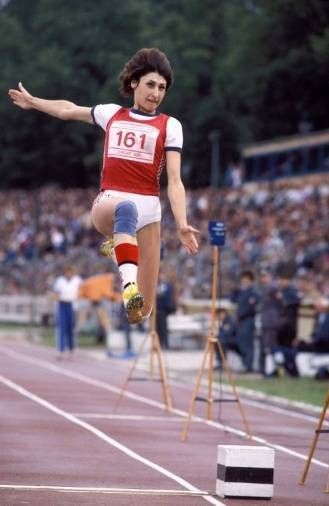 Galina Chistyakova, 1988. Source: https://www.eurosport.ru
Galina Chistyakova, 1988. Source: https://www.eurosport.ru
In June 1988 at the Znamensky Brothers Memorial in Leningrad, the Soviet long jumper Galina Chistyakova jumped at 7.52 meters. It has to be noted that the athlete set this world record, having performed the simpliest squat jump.
This result in women's long jumps is similar to the legendary “jump into the 21st century” by Bob Beamon,. The record is still unbeaten. Moreover, the today’s long jumpers can not even come close to the result of the Soviet female athlete.
Galina Chistyakova is the only woman in the Soviet Union and in Europe who began first to master the triple jump.
The famous duel of Carl Lewis and Mike Powell at the 1991 World Championships in Tokyo is considered to be one of the brightest events in the history of long jumps. For 10 years Lewis has known no defeat, won two Olympics (1984, 1988), managed to set the world record in a closed arena (8.79 m in 1984). Less titled Powell was the silver medalist of the 1988 Olympics in Seoul, had the best result in the world in 1990.
Before the final attempt, no one at the stadium had no doubt that Powell was unable to compete on an equal footing with Lewis, who was in brilliant sporting form. Having caught courage in the last attempt, Mike Powell made a fantastic 8.95 m jump, which made him a track and field legend and the current world record holder in long jump.
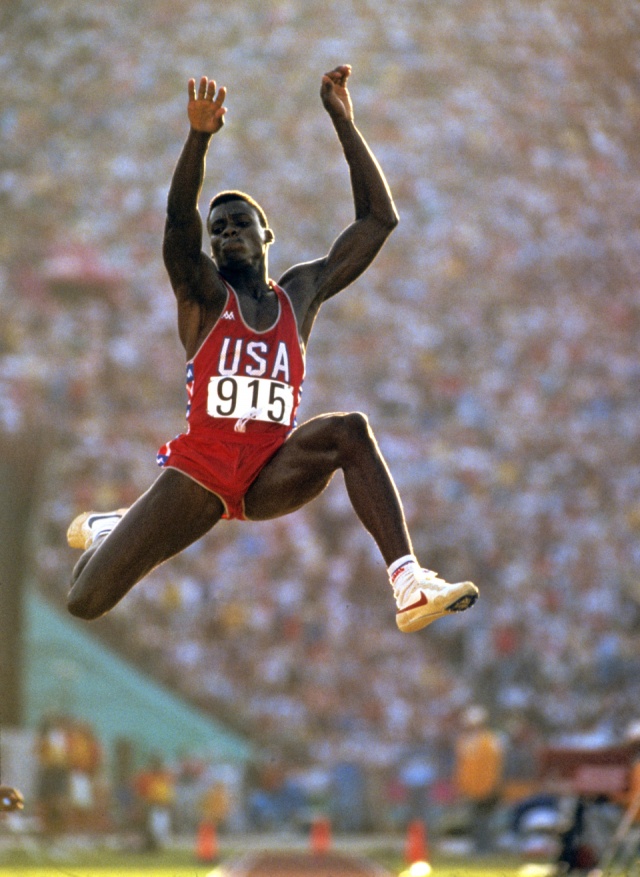 Carl Lewis at 1984 Olympics. Source: https://evivid.ru
Carl Lewis at 1984 Olympics. Source: https://evivid.ru
 Unbeaten jump by Mike Powell. Source: http://www.i-kiss.ru
Unbeaten jump by Mike Powell. Source: http://www.i-kiss.ru
Since 1924 official registration of records in athletics began in the USSR, which stimulated the growth of sporting achievements. Thus, the first BSSR record in men's long jump, recorded in 1924, was set by Leonty Lebedev at the Vitebsk stadium (5.53 m).
In August 1926 Minsk citizen Nikolai Kuzmin updates the record to 5.76 m. Later, during the I Republican Olympics, he was the first in the country to cross the six-meter mark (6.38 m), which was unbeaten for a long time.
The BSSR record for women (4.22 m), set in 1928, was unbeaten till 1935.
Long jumps were significantly developed by the introduction of the All-Union GTO complex in 1931 and the developed techniques for improving the long jump technique.
In 1936 a match meeting of athletes from Minsk, Vitebsk, Gomel, Bobruisk and Mogilev took place at the All-Belarusian Stadium. Jumpers Zinaida Lovetskaya, and then Alexandra Grinevich, updated the country’s record, having showed the same result, 4.94 meters. Athlete from Minsk Vyacheslav Sadovsky jumps to 6.39 meters.
In 1939 Nikolai Yanchevsky continued the traditions of the Minsk jumping school and improves the national achievement (6.82 m).
Since 1946 Alla Luppen has left a large footprint in the Belarusian sport. She is the country's many-time record holder in the long jump and sprint.
In 1949 Petr Zlotnikov from Gomel set the record twice: in Minsk he made a long jump to a distance of 6.89 m; then in Moscow he showed the result of 6.93 m.
From 1951 to 1957 Elena Gurvich (5.52 m and 5.67 m) and Tamara Lukyantseva (5.87 m in 1956 and 5.92 m in 1957) updated the records twice. In 1960 T. Lukyantseva was the first athlete in the BSSR to make long jumps to the distance of 6.06 m and 6.20 m.
In 1952 Boris Mikhalchuk was the first of the Belarusian athletes who jumped at 7.01 meters. Since 1955 athletes only from Minsk set records in the BSSR.
From 1968 to 1978 Valentin Kuzmenko held the title of record holder of the republic, having updated his result four times. He segt the record in 1973 (7.88 m), which had lasted for 5 years.
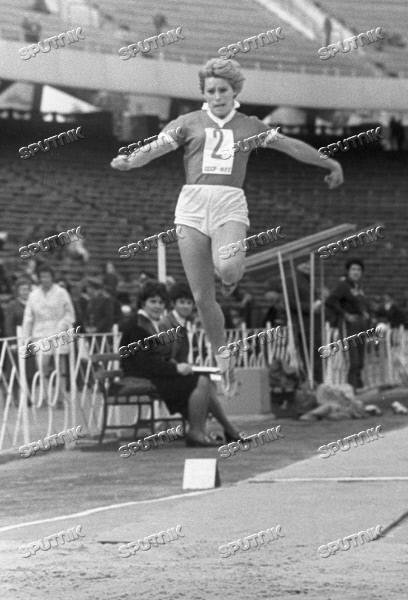 Alla Smirnova. Source: http://visualrian.ru
Alla Smirnova. Source: http://visualrian.ru
Growth of female records in this sport in the 1970s is associated with the names of two athletes Alla Smirnova and Lyudmila Borsuk. In 1970 the National Championship in Athletics was held in Minsk for the second time. The support of Belarusian fans helped Alla Smirnova from Minsk to become the champion of the USSR with a new republican record (6.35 m).
Excellent physical abilities and technical training allowed one of the best athletes to become a two-time record holder of the BSSR at the Spartakiad held in Moscow in 1971: 6.49 m in the long jump; 46.1 sec in the 4 x 400 relay race (as part of the national team). In 1976 Lidia Borsuk, participant of the 1976 Olympics in Montreal, set a republic record, 6.60 m.
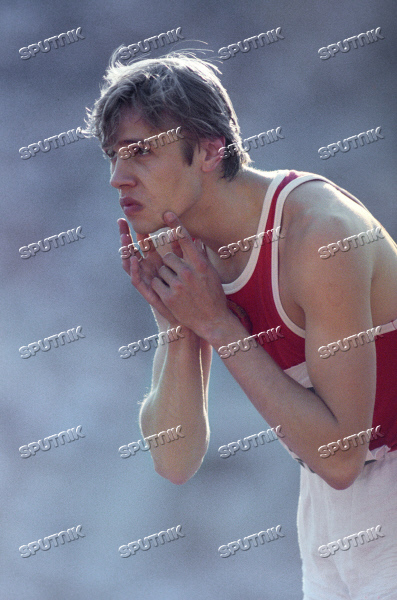 Victor Belsky. Source: http://visualrian.ru
Victor Belsky. Source: http://visualrian.ru
From 1978 to 1996 Victor Belsky, participant of the 1980 Olympics in Moscow, was the first in the republic to cross the eight-meter mark, was 8.10 m.
Since 1984 the confrontation between the two best jumpers in the history of Belarus, Irina Valyukevich and Elena Belevskaya, began. Irina Valyukevich set the records four times, Belevskaya made it seven times.
At the 1985 Summer Universiade in the Japanese city of Kobe Irina Valyukevich brought to the USSR youth team a gold medal with the result of 7.04 meters.
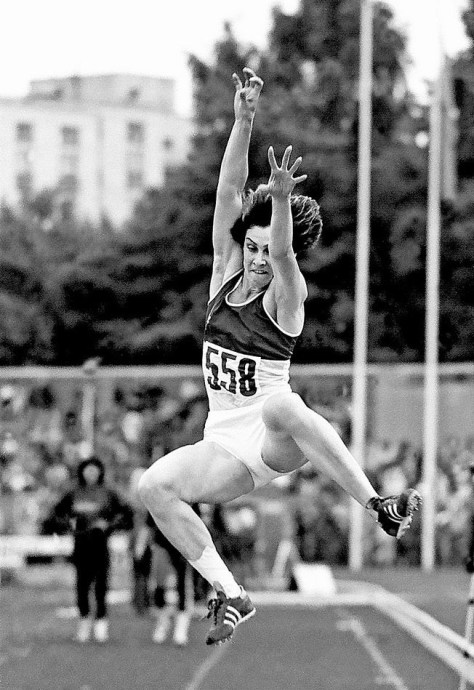 Elena Belevskaya, 1987. Source: http://bfla.eu
Elena Belevskaya, 1987. Source: http://bfla.eu
Elena Belevskaya is one of the most titled athletes in the history of the development of long jumps in Belarus. In 1986 she became the winner of the Spartakiad of Peoples of the USSR. Since that year, Elena Belevskaya has already become a permanent member of the USSR national track and field team and systematically defended the country's honor at various international sports forums. During 1986−1987 she won twice the title of champion of the Soviet Union.
The year of 1987 turned out to be very successful for Elena Belevskaya. So, at the first in the history of the World Indoor Championships, held in 1987 in Indianapolis (USA), the Belarusian jumper won the bronze medal (6.76 m). Two weeks later, Elena Belevskaya repeated this result, having won a bronze medal at the European Winter Championships in France.
 Elena Belevskaya. Source: https://www.klbviktoria.com
Elena Belevskaya. Source: https://www.klbviktoria.com
In the same year she updated the record of the USSR twice. In Moscow at the winter championship of the Soviet Union, she becomes a champion with a new record for the BSSR indoors (7.01 m). At the summer world championship in Rome she won a silver medal (7.14 m).
At the USSR Championship in Bryansk, Elena Belevskaya set a record for the USSR and the BSSR (7.39 m), which is still unbeaten, and won the title of champion. At the 1988 Olympics in Seoul she made it into the final and took the 4th place.
In 1991 theBelarusian Athletics Federation(BAF) became part of the International Amateur Athletics Federation.
On March 22, 1991 the National Olympic Committee of the Republic of Belarus (NOC RB) was established.
In March 1991 the BAF was admitted to the International Association of Athletics Federations as an independent federation.
Since 1993 the Belarusian national team performs as an independent team at the official international competitions.
Irina Chernushenko-Stasyukб six-time champion of Belarus in the long jump, winner of the European Cup, participant of the 2008 Olympics, left a large footprint on the history of this sport.
Olga Sudareva has been included in the national team of Belarus since 2007. At the European Championships in Helsinki (Finland) in 2012, she won a silver medal, having showed a result of 6.74 meters. She became the first athlete in the history of sovereign Belarus, who could win at the age of twenty. She is a participant of three summer Olympic games (Beijing 2008, London 2012, Rio de Janeiro 2016).
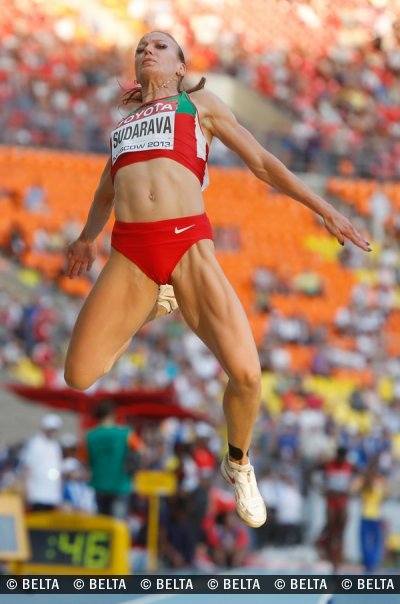 Olga Sudareva in Helsinki. Source: https://m.blr.belta.by
Olga Sudareva in Helsinki. Source: https://m.blr.belta.by
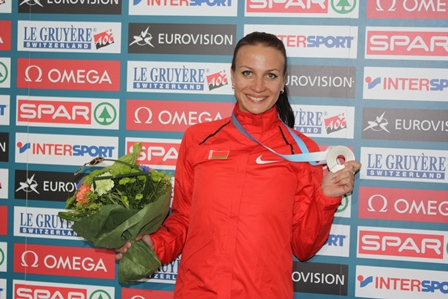 Olga Sudareva is the silver winner of the 2012 European Champion. Source: https://www.klbviktoria.com
Olga Sudareva is the silver winner of the 2012 European Champion. Source: https://www.klbviktoria.com
Anastasia Mironchik-Ivanova is a Belarusian athlete performing long jumps and triple jumps. She debuted at the 2008 World Junior Championship in Athletics in Bydgoszcz (Poland) and won a silver medal (6.46 m). In 2009, this ambitious athlete became a silver medalist at the U-23 Youth European Championships in Kaunas (Lithuania), having made a 6.76-meter jump.
Anastasia Mironchik-Ivanova is a Belarusian athlete performing long jumps and triple jumps. She debuted at the 2008 World Junior Championship in Athletics in Bydgoszcz (Poland) and won a silver medal (6.46 m). In 2009, this ambitious athlete became a silver medalist at the U-23 Youth European Championships in Kaunas (Lithuania), having made a 6.76-meter jump.
In 2011 Anastasia Mironchik-Ivanova won the bronze medal at the World Championships, held in Daegu (South Korea). Three-time champion of Belarus in outdoors (2012, 2015, 2018) and indoors (2011, 2015, 2018). After her maternity leave, she participated at the 2018 European Championship in Berlin, where she took part in the final (6.58 m).
 Anastasia Mironchik-Ivanova. Source: https://www.belta.by
Anastasia Mironchik-Ivanova. Source: https://www.belta.by
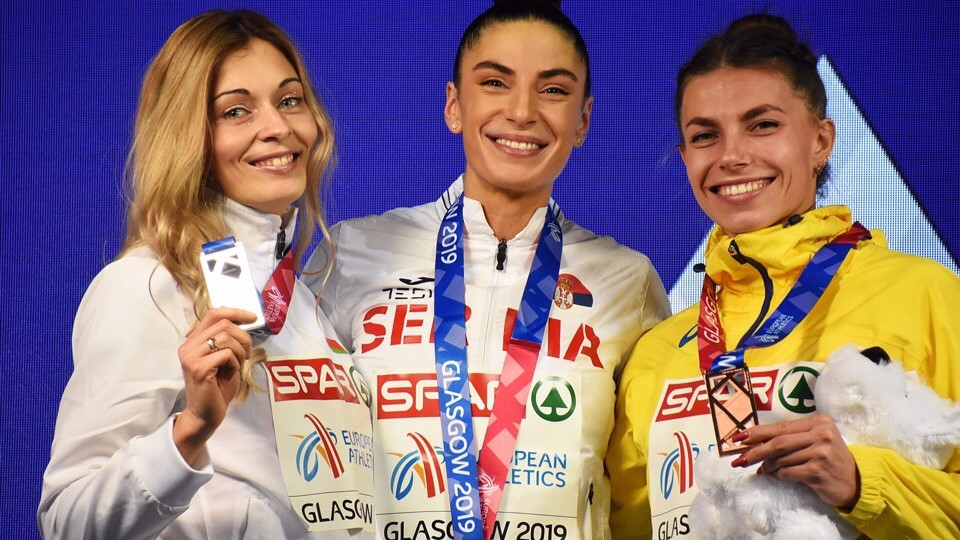 Anastasia Mironchik-Ivanova, the 2019 European Champion. Source: https://minsk2019.by
Anastasia Mironchik-Ivanova, the 2019 European Champion. Source: https://minsk2019.by
At the 2019 European Championships in Glasgow (United Kingdom), she won silver and set a personal record indoors (6.93 m).
Anastasia Mironchik-Ivanova is one of the most promising athletes in the country. Now our athlete is among the top ten in Europe.
At present time an excellent material base for the development of all types of athletics, including long jumps has been created in the country. We can be proud of our talented young people, who are internationally competitive, and our juniors have also been pleased with worthy results.
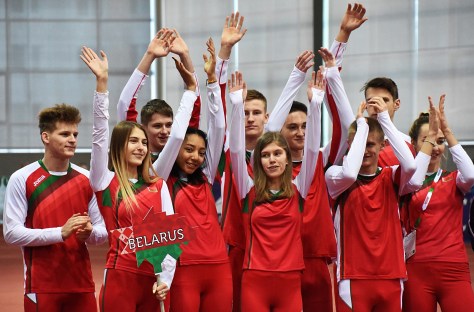 National junior team. Source: http://bfla.eu
National junior team. Source: http://bfla.eu
At the Republican Spartakiad of the sports and junior sports schools of the Republic of Belarus in Athletics which was held in Gomel, two talented juniors showed themselves. One of them, Anastasia Antsuh, has been a member of the national team since 2018. Over the past three years, she has been a leader among her peers, having become the winner of sports tournaments, the Republican Spartakiad of pupils, and the Baltic Games 2017.
Sports experts note young star Polina Zlotnikova, who shows the results of the European top level for the second season in a row.
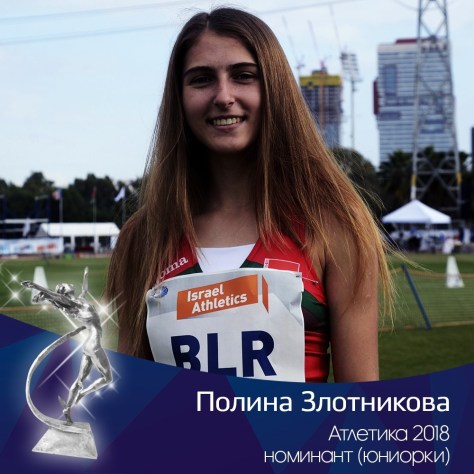 Polina Zlotnikova, record holder (U-20). Source: http://bfla.eu
Polina Zlotnikova, record holder (U-20). Source: http://bfla.eu
In 2018 Polina Zlotnikova became the silver medalist of the adult National Long Jump Championship, and then won the international match for juniors in Minsk with a personal record (6.03 m). A few months later, at the international competitions in Tel Aviv (Israel), the talented athlete won a silver medal, and became a bronze medalist at the Belarus Cup.
In the open championship of Belarus on the renovated Dynamo stadium, the junior athlete also won the bronze medal. In December 2018 Polina Zlotnikova set a personal record (6.33 m), repeating the national record for juniors.
The national team of the Republic of Belarus in the long jump http://bfla.eu/wp-content/uploads/2015/01/2019.pdf
Javelin throw is a track and field event where an implement with aerodynamic properties is thrown as far as possible. It consists of the run-up, the transition and the delivery. A javelin thrown at an angle to the horizon is affected by the resistance force, the lifting force and the direction of the wind. This discipline requires strong throws, dexterity, flexibility and coordination of movements from athletes. Javelin throw is included in the technical types of athletics.
Javelin throwing was vital for a primitive man: spears and harpoons (turned sticks) were used everywhere. Due to the ease of manufacture and versatility, the spear was a favorite weapon for hunting and war.
 Cave bear and Neanderthals. Source: https://potokmedia.ru
Cave bear and Neanderthals. Source: https://potokmedia.ru
As a sports implement, the javelin began to be used in ancient Greece. Gradually it improved. They began to attach a leather loop to the middle of the shaft for the convenience. The Greeks called it "emma", and the Romans "ementum."
Javelin throw was first included in the program of competitions of the 16th Olympiad (708 BC). In the new track and field athletics – pentathlon – the ancient Greeks competed in running, throwing a disc and a spear, long jumping and wrestling. According to Aristotle, these competitions most harmoniously developed the body of the Greek athlete.
![Ancient [Greek] Athletics. Source: https://noveltour.livejournal.com](/upload/medialibrary/94e/29035586716_dcb2ccc94b_b.jpg) Ancient [Greek] Athletics. Source: https://noveltour.livejournal.com
Ancient [Greek] Athletics. Source: https://noveltour.livejournal.com
Spear throwers competed in accuracy, hitting the target. The target was set on the ground or painted on the wall. By participating in the Olympic pentathlon, the Greeks tried to throw the spear as far as possible. Sometimes the metal tip was removed in order to avoid an accident, the victim of which could be careless spectators.
In the first century AD, spears were used by Roman warriors exclusively for combat. The main advantage of the javelin was that it could be thrown with one hand, so it was often used by riders.
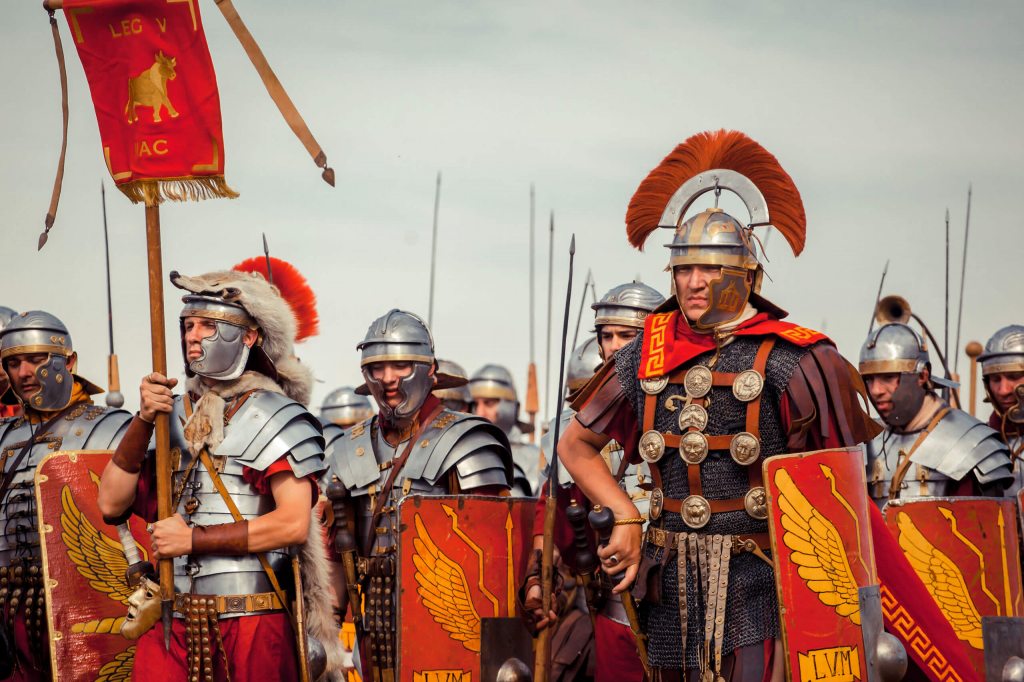 Roman legion. Source: https://4knigaman.ru
Roman legion. Source: https://4knigaman.ru
When gunpowder and firearms were invented, the military significance of the spear lost its relevance for the infantry, but still remained important for the cavalry.
In fifteen-century Europe, with the growing popularity of knightly tournaments, a new type of weapon appeared: a tournament spear, not intended for combat. Tournament spears were hollow inside, and the combat tip was usually changed to safe one.
In the 19th century, javelin throw was considered an elite form of athletics, practiced by members of aristocratic and wealthy families.
First javelin throw competitions began to be held in the north of Europe in the Scandinavian countries: in Finland from 1883, in Sweden from 1886, and in Norway from 1891.
In 1902, the International Olympic Committee decided to include demonstrations in javelin throw into the program of the “jubilee” extraordinary Olympiad of 1906. The weight and dimensions of the implement for men were determined. The spear was supposed to be a shaft with a length of 2 m 60 cm and weigh 800 gm, with a winding for holding and a metal tip.
Swedish and Finnish athletes are the founders of modern spear throwing technique. They threw a spear, resting their fingers on the strongest hand on the tail of the spear, and with their other hand supported it by the middle. This style was called "free." In the "Greek" style, the spear was usually held onto the end, and the second hand was a fulcrum.
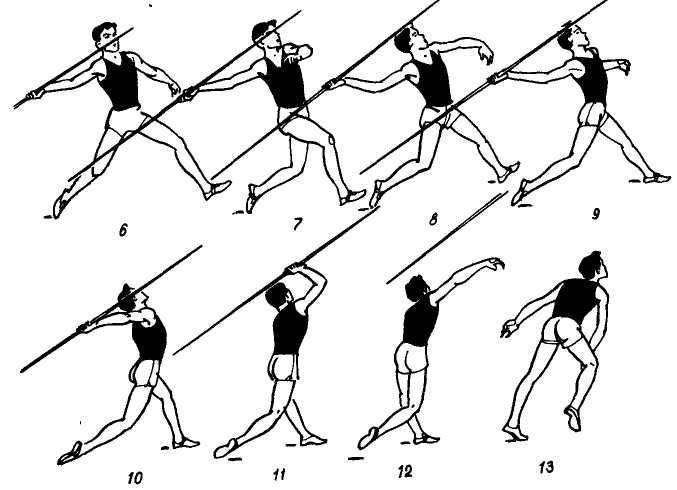 Javelin throw – Swedish techniques. Source: https://studfiles.net
Javelin throw – Swedish techniques. Source: https://studfiles.net
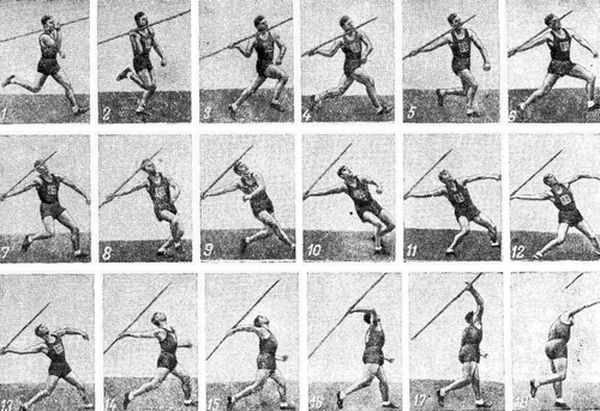 Victor Tsybulenko – Finnish techniques. Source: https://rusatletik.ru
Victor Tsybulenko – Finnish techniques. Source: https://rusatletik.ru
Javelin throw as a sports discipline appeared only at the Fourth Olympic Games (London, 1908), and at the same time in two versions: freestyle javelin and Greek style. In both variants, the first winner at the Olympics was a Swede Eric Lemming (54 m 44cm).
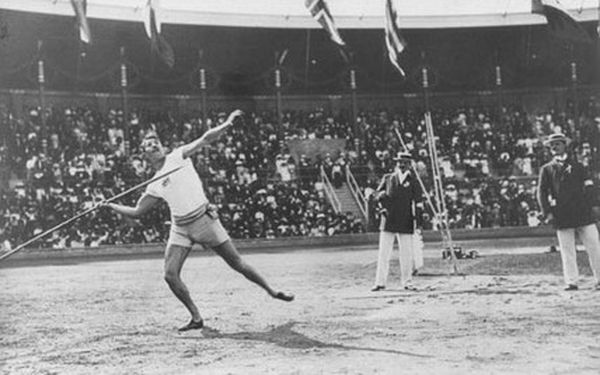 Eric Lemming, the two-time Olympic Champion. Source: https://rusatletik.ru
Eric Lemming, the two-time Olympic Champion. Source: https://rusatletik.ru
In 1908, modern technique was legalized: throwing a projectile from behind a head over a shoulder with one hand. In 1912, at the Olympics in Stockholm, an unsuccessful attempt was made to introduce the idea of the ancient Greeks about the harmonious development of athletes in javelin throw competitions. To do this, spear throwers had to throw it with their right and left hands.
In 1912, Erik Lemming of Sweden, supported by his fellow fans, won the champion title again and set the first world record in javelin throw: 62 m 32 cm. In his attempts, he demonstrated a rational way of holding the implement and carrying it during a run over the shoulder. In the final steps of the run, the athlete retracted the implement with a slight twist and body tilt.
Joonas "Jonni" Myyrä, the two-time champion of the Seventh Olympiad (1920, Antwerp, Belgium) and the Eighth Olympiad (1924, Paris, France), did a lot to improve the “Finnish” javelin throw technique.
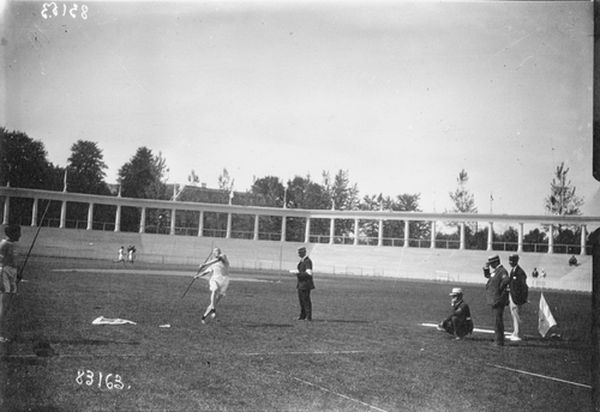 Joonas "Jonni" Myyrä. Source: https://rusatletik.ru
Joonas "Jonni" Myyrä. Source: https://rusatletik.ru
His rapid run-up, ending in a wide and rhythmic swing, for many years was a model for throwers of subsequent generations.
In 1932, the outstanding Finnish athlete Matti Järvinen became the champion of the Olympic Games in Los Angeles, improving the Olympic record by more than 6 meters: 72 meters 71 cm. In honor of Järvinen’s victory, a tower with a height equal to the record length of his javelin was built at the Olympic Stadium in Helsinki. From 1930 to 1936, the Finnish javelin thrower set 10 world records, the last of which was 77 m 23 cm.
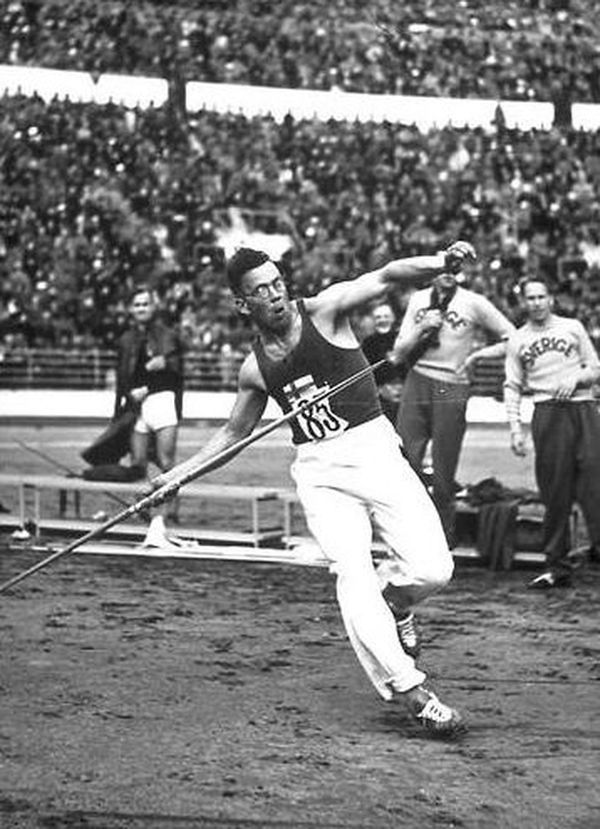 Matti Järvinen. Source: https://rusatletik.ru
Matti Järvinen. Source: https://rusatletik.ru
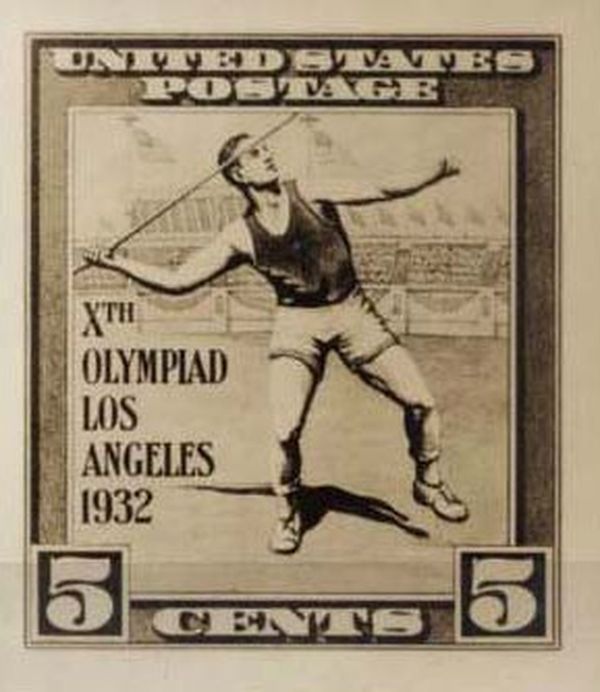 Matti Järvinen, the champion of the 1932 Olympics. Source: https://rusatletik.ru
Matti Järvinen, the champion of the 1932 Olympics. Source: https://rusatletik.ru
Järvinen also had the privilege of perfecting the Finnish style, which became widespread throughout the world. Järvinen’s smooth, gradually accelerating run-up ended with quick steps, when the legs and body “overtook” the implement, creating the most advantageous position for the throw. Afterwards, the athlete assumed the later position of the classic “stretched bow,” from which he made a powerful throw, putting into this movement the force of the whole body, starting from the legs and ending with the hand.
Since 1932, women began to take part in javelin throw competitions. The weight and size of the implement for women were determined. The javelin was supposed to be a shaft with a length of 2 m 30 cm and weigh 600 gm, with a winding for holding and a metal tip.
The first female champion in this discipline was Mildred Didrikson of the United States, who threw a spear with a result of 43 m 68 cm. One of the most prominent athletes of our time, she performed in different types of athletics and sports and almost everywhere achieved excellent results.
In the 1950s, a new type of sports javelin, invented by the brothers Held (USA), was introduced. In 1953, it was allowed to use a metal Held javelin at competitions, and in the same year one of the brothers threw the implement at 80 m 41 cm.
The center of gravity was changed and the diameter of the shaft was increased, thanks to which the javelin began to fly longer and descend later. The athletes were able to significantly raise the ceiling of the world record.
In 1964, Terje Pedersen of Norway was the first in the world to throw a javelin at 91 meters 72 cm. After 20 years, Uwe Hohn of East Germany showed an outstanding result: 104 m 80 cm (the javelin flew almost the entire stadium).
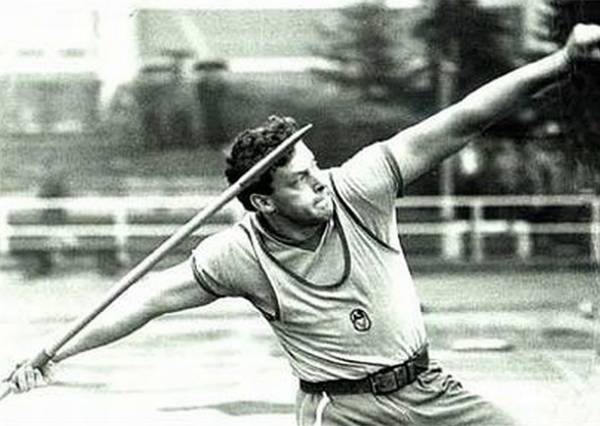 Uwe Hohn of East Germany. Source: http://www.i-kiss.ru
Uwe Hohn of East Germany. Source: http://www.i-kiss.ru
Such long throws raised the issue of the safety of javelin throw competitions, and from April 1, 1986, the IAAF (International Association of Athletics Federations) decided to change the design of the javelin, shifting the center of gravity closer to the tip.
In 1987, the three-time Olympic champion Jan Železný of the Czech Republic set a new record: 87 m 66 cm. Nine years later, he showed the result of 98 m 48 cm. This record has not yet been surpassed.
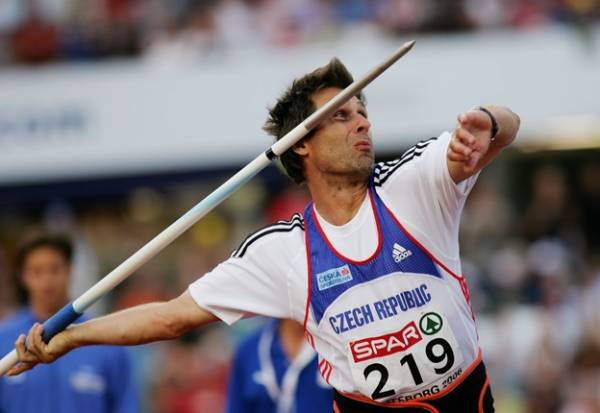 Jan Železný. Source: http://www.i-kiss.ru
Jan Železný. Source: http://www.i-kiss.ru
In 1991, any changes to the implement were prohibited. The throw of Seppo Räty of Finland at a distance of 96 m 96 cm, made with a modified javelin, was canceled.
Since 1988, women also started to switch to a new design, but they continue to throw the old “planning” javelin; the results of both standards are fixed.
In 1987, Petra Felke-Meier of Germany threw a javelin of the old model at 78 m 90 cm, and in 1988 she threw it at exactly 80 m. This female record still holds today.
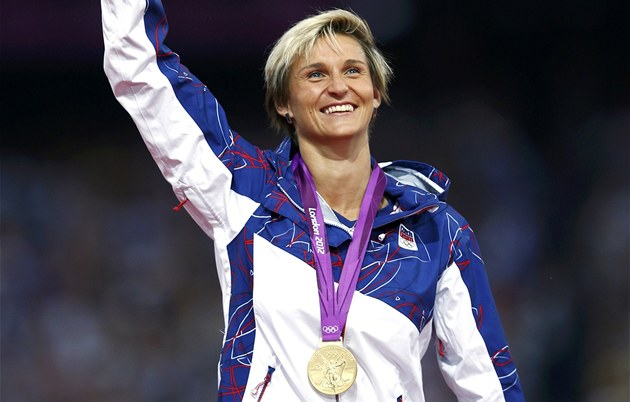 The two-time Olympic Champion Barbora Špotáková. Source: http://mir-la.com
The two-time Olympic Champion Barbora Špotáková. Source: http://mir-la.com
At the 2008 World Championships, Barbora Špotáková of the Czech Republic set a record of 72 m 28 cm in throwing a new javelin type.
Currently, javelin throw is very popular in Europe, the USA and Cuba. In the countries of South America, on the Asian and African continents, this sport is not widely spread.
In the BSSR, the development of javelin throwbegan after the Great October Socialist Revolution.
The first record of the republic was set in 1936 by Sergey Petrenek (52 m 02 cm). This record lasted 12 years.
In 1948, Pavel Zlotnikov set a new record: 56 m 38 cm.
In the post-war period, many young people came to track and field. The athletes A. Volkov, Petr Makruk, Nicolay Tarasyuk and Fedor Listopad showed results close to 70 m.
In 1958, the 70-meter mark was crossed and the BSSR records were set by Mikhail Thur (74 meters 20 cm) and Mikhail Dostanko (75 meters 22 cm).
The successes of female javelin throwers are primarily associated with Vera Nabokova (coach Boris Levinson), who set the republican record in Berlin in 1951: 50 m 90 cm, which lasted 13 years.
Then the leaders in javelin throw in Belarus were Maria Dubograeva (56 m 60 cm), Dina Kuryan (61 m 30 cm), Lyudmila Pasternakevich (63 m 86 cm), Nina Yermolovich (69 m 86 cm), Natalia Shikolenko (71 m 44 cm). They were part of the national team of the USSR, successfully performing at major international competitions.
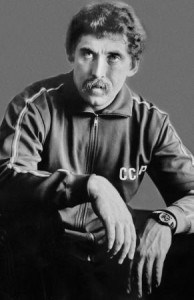 Nikolai Grebnev. Source: http://bfla.eu
Nikolai Grebnev. Source: http://bfla.eu
In the 1970s, Ivan Morgol (82 m 80 cm, bronze medalist of the Games of the Peoples of the USSR) and Vladimir Protas (84 m 42 cm) became the leading athletes. Nikolai Grebnev was a silver medalist of the European Championship, winner of the Games of the Peoples of the USSR and the European Cup, and five-time champion of the Znamensky Brothers Memorial. His record is 89 meters 82 cm.
In 1985, Viktor Bochin updates the BSSR record using an old-style javelin: 90 m 04 cm.
Vladimir Sasimovich (coach Vasily Perednya) became the leader among Belarusian javelin throwers. The promising athlete won the title of world champion among juniors and the title of champion of the USSR, took top places at major international competitions, and also set a new record of Belarus with a new type javelin: 87 m 40 cm (1995), valid to this day.
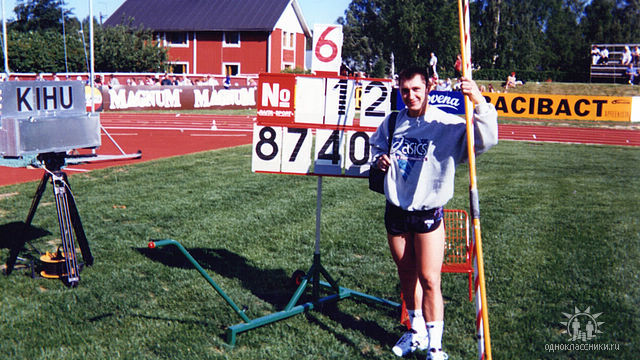 Vladimir Sasimovich at the competition in Kuartane (Finland), 1994. Author: Denis Misyulya. Source: https://shkolazhizni.ru
Vladimir Sasimovich at the competition in Kuartane (Finland), 1994. Author: Denis Misyulya. Source: https://shkolazhizni.ru
In 1991, the Belarusian Athletics Federation (BFLA) became part of the International Amateur Athletics Federation.
On March 22, 1991, the National Olympic Committee of the Republic of Belarus (NOC RB) was established.
In March 1991, BFLA was admitted to the International Association of Athletics Federations as an independent federation.
Since 1993, the Belarusian national team performs at the official international competitions as an independent team.
In 1992, Natalya Shikolenko, a member of the national team of the CIS, won a silver medal at the Olympic Games in Barcelona (Spain).
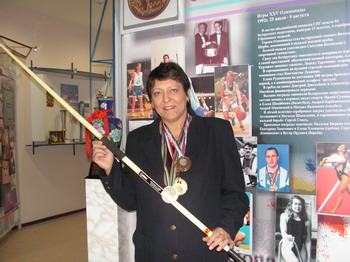 Natalya Shikolenko. Source: https://www.klbviktoria.com
Natalya Shikolenko. Source: https://www.klbviktoria.com
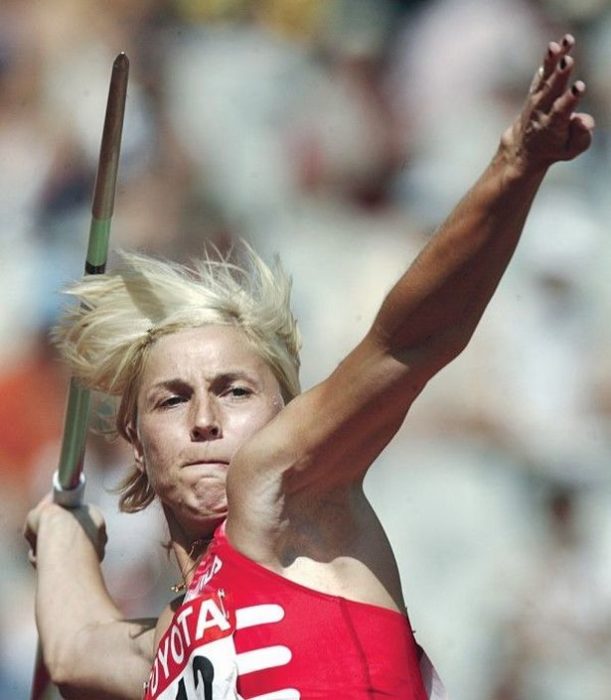 Natalia Sazanovich. Source: https://delaemvmeste.by
Natalia Sazanovich. Source: https://delaemvmeste.by
In 1996, Natalia Sazanovich inscribed a glorious page in the history of sovereign Belarus. The thrower from Baranovichi became the Olympic silver medalist in javelin throw in Atlanta (USA).
In recent years, Tatiana Kholodovich, an athlete from Pinsk, has firmly taken the lead in the national team. The European Champion 2016 successfully performs at international javelin throw competitions. Twice she became the winner on the stages of the Diamond League in Zurich and Oslo, setting the national record of Belarus (67 m 47 cm).
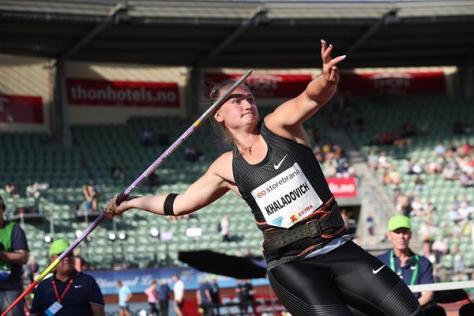 Tatiana Kholodovich. Source: http://bfla.eu
Tatiana Kholodovich. Source: http://bfla.eu
The talented juniors are growing up in Belarusian sports. Anna Tarasyuk is a silver medalist of the 2013 European Youth Olympic Festival, the winner of the 2013 Eurasian Games and the 2013 World School Games.
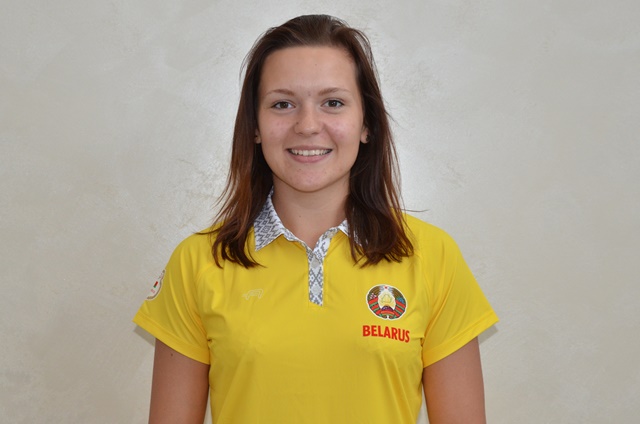 Anna Tarasyuk. Source: http://www.athletics.by
Anna Tarasyuk. Source: http://www.athletics.by
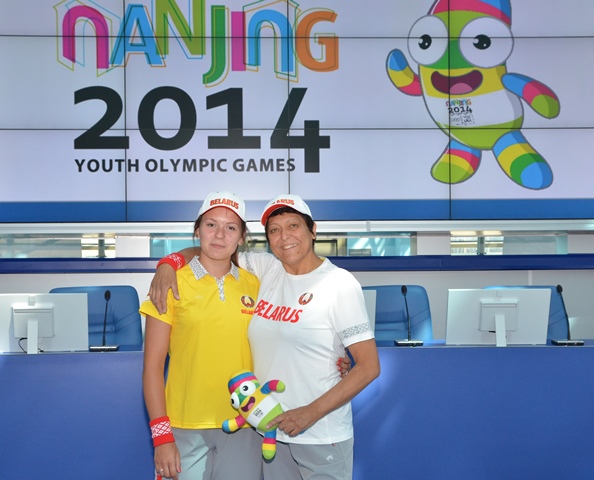 Anna Tarasyuk with her mother. Source: http://www.athletics.by
Anna Tarasyuk with her mother. Source: http://www.athletics.by
Anna Tarasyuk set a sensational record at the World School Games and became a champion in javelin throw. The World School Games includes a complex of international competitions for schoolchildren aged from 14 to 17 years from different countries. Its uniqueness is that an athlete can take part in competitions of this level only once.
In 2014, in Nanjing, at the Second Youth Olympic Games, the young spear thrower won a gold medal and set a national record for girls (55 m 70 cm). She is a trainee of her mother, a silver medalist of the 1992 Olympics Natalia Shikolenko.
The national javelin throw team of the Republic of Belarus http://bfla.eu/wp-content/uploads/2015/01/2019.pdf
 The BAF logo http://bfla.eu
The BAF logo http://bfla.eu
Public Association "Belarusian Athletics Federation"
Official website: http://bfla.eu
Скачать список литературы в формате pdf.
Books:
- Алабин, В. Г. Многолетняя подготовка легкоатлетов: (на примере скоростно-силовых видов) / В. Г. Алабин. – Минск : Выш. шк., 1981. – 206 с.
- Бойко, В. В. Прыжки в небо / В. В. Бойко. – Минск : Полымя, 1990. – 96 с.
- Вацула, Й. Азбука тренировки легкоатлета / Й. Вацула, Э. Достал, В. Вомачка. – Минск : Полымя, 1986. – 135 с.
- Гаусман, К. И. Легкая атлетика/ К. И. Гаусман. – Минск : Урожай, 1968. – 42 с.
- Игнатищев, Р. М. Прыгать можно дальше 10-ти метров / Р. М. Игнатищев. – Могилев : Белорус.-Рос. ун-т, 2005. – 29 с.
- Легкая атлетика : [учеб. пособие / Б. Б. Левинсон и др.]. – Изд. 2-е, испр. и доп. – Минск : Выш. шк., 1968. – 237 с.
- Легкая атлетика в Беларуси : справочник / сост.: С. А. Зыков, В. В. Фаворский. – Минск : Ковчег, 1998. – 47 с.
- Техника и методика обучения барьерному бегу и бегу с препятствиями : метод. рекомендации / [сост.: В. И. Тур и др.] ; Витеб. гос. ун-т . – Витебск : ВГУ, 2008. – 33 с.
- Юшкевич, Т. П. Тренажеры в легкой атлетике : пособие / Т. П. Юшкевич, А. В. Ворон. – Минск : БГУФК, 2014. – 92 с.
Publications:
- Герман, Э. «Меня восхищают люди, которые не сдаются перед трудностями» / Эльвира Герман // Наш спорт. – 2018. – № 4. – С. 4–6.
- Мясников, В. Виктор Мясников: «Люди что–то меняют в жизни, и это нормально» / В. Мясников // Спортtime. – 2018. – № 7. – С. 18–21.
- Осипенко, А. Чемпионы ветеранами не бывают / А. Осипенко // Беларус. думка. – 2008. – № 7. – С. 101–105.
- Талай, А. «В спорте нельзя загадывать: кому удача улыбнется сегодня, а кому завтра» / А. Талай // Наш спорт. – 2017. – № 4. – С. 2–4.
- Талай, А. «Для спортсмена важно постоянно ставить себе новые цели» / А. Талай // Наш спорт. – 2018. – № 2. – С. 34–35.
Information resources:
- «Еще должен прибавить». Как белорусский юниор побил 40-летний рекорд Европы в прыжках в высоту [Электронный ресурс] // TUT.BY / Белорусский портал. – Режим доступа: https://sport.tut.by/news/athletics/554106.html. – Дата доступа : 25.04.2019.
- «Уйдете — обратно я не принимаю». Как бывший тренер Талай подготовил новую чемпионку Европы Герман [Электронный ресурс] // TUT.BY / Белорусский портал. – Режим доступа: https://sport.tut.by/news/athletics/604433.html?crnd=60766. – Дата доступа : 25.04.2019.
- «Черная пуля» против Гитлера [Электронный ресурс] // HumanInside. – Режим доступа: https://humaninside.ru/za-uglom-istorii/48652-chernaya_pulya_protiv_gitlera.html. – Дата доступа : 25.04.2019.
- 22 августа. События... [Электронный ресурс] // LiveInternet. – Режим доступа: https://www.liveinternet.ru/users/kakula/post439454344/. – Дата доступа : 25.04.2019.
- 29 мая. События в мире 1956-1966гг [Электронный ресурс] // LifeInternet. – Режим доступа: https://www.liveinternet.ru/users/1641535/post435593470. – Дата доступа : 25.04.2019.
- 75-летний юбилей Владислава Сапеи [Электронный ресурс] // Гомельский государственный университет имени Франциска Скорины. – Режим доступа: http://physcult.gsu.by/index.php/75-letnij-yubilej-vladislava-sapei/. – Дата доступа : 25.04.2019.
- De Grasse posts fastest 200 metre time in Olympic heats at Rio 2016 [Электронный ресурс] // Canadian Olympic Team Official Website. – Режим доступа: https://olympic.ca/2016/08/16/de-grasse-posts-fastest-200-metre-time-in-olympic-heats-at-rio-2016/. – Дата доступа : 25.04.2019.
- El album de Edwin Moses [Электронный ресурс] // MundoDeportivo. – Режим доступа: https://www.mundodeportivo.com/20130923/fotos/el-album-de-edwin-moses_54388778511.html#5. – Дата доступа : 25.04.2019.
- ESTADOS UNIDOS - CAMPEOES OLIMPICOS: 2015 [Электронный ресурс] // Blogspot. – Режим доступа: http://og-eua.blogspot.com/2015/. – Дата доступа : 25.04.2019.
- Etes-vous plutot Sportswear chic ou Streetwear? [Электронный ресурс] // Rien a se mettre. – Режим доступа: https://www.rienasemettre.fr/sportswear-chic-streetweat-nouvelles-tendances/. – Дата доступа : 25.04.2019.
- Genius [Электронный ресурс] // WordPress. – Режим доступа: https://chereek.wordpress.com/2009/09/22/genius/. – Дата доступа : 25.04.2019.
- Kevin Young (hurdler) [Электронный ресурс] // Alchetron / Free Social Encyclopedia for the World. – Режим доступа: https://alchetron.com/Kevin-Young-(hurdler). – Дата доступа : 25.04.2019.
- Kevin Young [Электронный ресурс] // USA Track & Field. – Режим доступа: http://www.usatf.org/halloffame/TF/showBio.asp?HOFIDs=218. – Дата доступа : 25.04.2019.
- Londra 2012, corsa a ostacoli [Электронный ресурс] // Ilpost. – Режим доступа: https://www.ilpost.it/2012/08/07/londra-2012-ostacoli/. – Дата доступа : 25.04.2019.
- Long jump [Электронный ресурс] // Hyperleap. – Режим доступа: https://hyperleap.com/topic/Long_jump. – Дата доступа : 25.04.2019.
- OS-historia for nordar (och er andra) [Электронный ресурс] // Sveriges Radio. – Режим доступа: https://sverigesradio.se/sida/artikel.aspx?programid=105&artikel=6496569. – Дата доступа : 25.04.2019.
- Tatyana Ledovskaya [Электронный ресурс] // Нац. олимп. ком. Респ. Беларусь. – Режим доступа: http://www.noc.by/en/olympic-games/team/chempiony-olimpijskih/ledovskaya-tatyana-mikhajlovna-legkaya-atletika/. – Дата доступа : 25.04.2019.
- А как все хорошо начиналось... [Электронный ресурс] // LIVEJOURNAL. – Режим доступа: https://noveltour.livejournal.com/312682.html. – Дата доступа : 25.04.2019.
- Алина Талай: биография, фото, личная жизнь [Электронный ресурс] // Nastroy. – Режим доступа: https://www.nastroy.net/post/alina-talay-biografiya-foto-lichnaya-jizn. – Дата доступа : 25.04.2019.
- Анастасия Мирончик-Иванова стала финалисткой ЧМ по легкой атлетике в прыжках в длину [Электронный ресурс] // БЕЛТА / Новости Беларуси. – Режим доступа: https://www.belta.by/sport/view/anastasija-mironchik-ivanova-stala-finalistkoj-chm-po-legkoj-atletike-v-pryzhkah-v-dlinu-160409-2015/. – Дата доступа : 25.04.2019.
- Барбора Шпотакова осталась довольна итогами нынешнего сезона [Электронный ресурс] // MIR-LA / Спортивный информационный ресурс. – Режим доступа: http://mir-la.com/7931-barbora-shpotakova-ostalas-dovolna-itogami-nyneshnego-sezona.html. – Дата доступа : 25.04.2019.
- Бегун (долихос) [спорт] [Электронный ресурс] // Универсальная энциклопедия Кирилла и Мефодия. – Режим доступа: https://megabook.ru/media/Бегун%20(долихос)%20%5bспорт%5d. – Дата доступа : 25.04.2019.
- Бегун на старте (бронзовая статуэтка) [спорт] [Электронный ресурс] // Универсальная энциклопедия Кирилла и Мефодия. – Режим доступа: https://megabook.ru/media/Бегун%20на%20старте%20(бронзовая%20статуэтка)%20%5bспорт%5d. – Дата доступа : 25.04.2019.
- Беларусы на чэмпіянаце свету па лёгкай атлетыцы [Электронный ресурс] // БЕЛТА / Навiны Беларусi. – Режим доступа: https://m.blr.belta.by/fotoreportage/view/belarusy-na-chempijanatse-svetu-pa-legkaj-atletytsy-38366-2013. – Дата доступа : 25.04.2019.
- Бланкерс-Кун, Фанни [Электронный ресурс] // PeopleLife. – Режим доступа: https://www.peoplelife.ru/35637. – Дата доступа : 25.04.2019.
- Болт признан спортсменом года по версии IAAF [Электронный ресурс] // Sporter. – Режим доступа: https://sporter.md/ru/posts/legkaya-atletika/bolt-priznan-sportsmenom-goda-po-versii-iaaf. – Дата доступа : 25.04.2019.
- Большое сообщение прыжки через планку. Контрольная работа: Классификация видов прыжков в высоту [Электронный ресурс] // Ecoprog. – Режим доступа: https://ecoprog.ru/a-great-message-jumping-over-the-bar-test-work-classification-of-high-jump-types.html. – Дата доступа : 25.04.2019.
- Бостон Ральф [Электронный ресурс] // Этот день в истории спорта. – Режим доступа: http://sport-calendar.ru/lichnosti-v-sporte/item/boston-ralf. – Дата доступа : 25.04.2019.
- В Бресте обновлён 25-летний рекорд Беларуси по прыжкам в высоту [Электронный ресурс] // СТВ. – Режим доступа: http://www.ctv.by/novosti-bresta-i-brestskoy-oblasti/v-breste-obnovlyon-25-letniy-rekord-belarusi-po-pryzhkam-v-vysotu. – Дата доступа : 25.04.2019.
- Валерий Брумель: биография, фото, причина смерти [Электронный ресурс] // FB. – Режим доступа: http://fb.ru/article/216216/valeriy-brumel-biografiya-foto-prichina-smerti. – Дата доступа : 25.04.2019.
- Ваш день рождения 26 июня [Электронный ресурс] // Ваш день рождения. – Режим доступа: https://366days.ru/26_iyunya/. – Дата доступа : 25.04.2019.
- Вильгельмина Бардаускене и Мировой рекорд, установленный в Кишиневе. [Электронный ресурс] // Мой мир в фотографиях. – Режим доступа: http://moimir.org/vilgelmina-bardauskene-i-mirovoj-rekord-ustanovlennyj-v-kishineve. – Дата доступа : 25.04.2019.
- Владимир Ященко. Взлет и падение. 12 января исполнилось бы 54 года гениальному запорожскому спортсмену — прыгуну в высоту [Электронный ресурс] // Хроники и комментарии / Интернет-газета. – Режим доступа: https://operkor.wordpress.com/2013/01/15/%D0%B2%D0%BB%D0%B0%D0%B4%D0%B8%D0%BC%D0%B8%D1%80-%D1%8F%D1%89%D0%B5%D0%BD%D0%BA%D0%BE-%D0%B2%D0%B7%D0%BB%D0%B5%D1%82-%D0%B8-%D0%BF%D0%B0%D0%B4%D0%B5%D0%BD%D0%B8%D0%B5-12-%D1%8F%D0%BD%D0%B2%D0%B0/. – Дата доступа : 25.04.2019.
- Дмитрию Набокову покорилась высота 2.32 на мемориале Е.И. Сосиной по прыжкам в высоту + протоколы [Электронный ресурс] // БФЛА / Белорусская федерация легкой атлетики. – Режим доступа: http://bfla.eu/?p=32397. – Дата доступа : 25.04.2019.
- Древние Олимпийские игры [Электронный ресурс] // Интересник. – Режим доступа: http://interesnik.net/drevnie-olimpijskie-igry/. – Дата доступа : 25.04.2019.
- Елена Белевская - королева по прыжкам в длину, рекордсменка Беларуси - 7.39!!! [Электронный ресурс] // Клуб любителей бега «Виктория». – Режим доступа: https://www.klbviktoria.com/novosti/2012-god/fevral/13-02-2012-3.html. – Дата доступа : 25.04.2019.
- Интервью с Чистяковой [Электронный ресурс] // EUROSPORT. – Режим доступа: https://www.eurosport.ru/athletics/olympic-games-london/2012/story_sto3361727.shtml. – Дата доступа : 25.04.2019.
- Искусство преодоления. Барьерный бег: техника и правила. [Электронный ресурс] // «Russiarunner» / Портал о беге в радость.. – Режим доступа: http://www.russianrunner.ru/trenirovka/iskusstvo-preodoleniya. – Дата доступа : 25.04.2019.
- Как сделать деревянные козлы своими руками для ремонта и пилки дров [Электронный ресурс] // Легкое дело. – Режим доступа: http://legkoe-delo.ru/remont-doma/melkij-remont/70794-kak-sdelat-derevyannye-kozly-svoimi-rukami-dlya-remonta-i-pilki-drov. – Дата доступа : 25.04.2019.
- Легендарные спортивные фотографии Нила Лейфа [Электронный ресурс] // Evivid. – Режим доступа: https://evivid.ru/legendarnye_sportivnye_fotografii_nila_leyfa.html. – Дата доступа : 25.04.2019.
- Легкоатлетические барьеры: виды, история возникновения, правила использования [Электронный ресурс] // «Спортстайл». – Режим доступа: https://sportstyle-shop.com/articles/legkoatleticheskie-barery/. – Дата доступа : 25.04.2019.
- Легкоатлетки Мирончик-Иванова и Герман – призеры ЧЕ-2019 в помещении [Электронный ресурс] // Minsk2019. – Режим доступа: https://minsk2019.by/ru/news/925. – Дата доступа : 25.04.2019.
- Лос-Анджелес-1932 [Электронный ресурс] // Олимпийский Архив. – Режим доступа: http://www.olympichistory.info/s1932.html. – Дата доступа : 25.04.2019.
- Лучшие спортсмены Беларуси. Часть 1 (1959 – 1969) [Электронный ресурс] // Делаем вместе. – Режим доступа: https://delaemvmeste.by/luchshie-sportsmenyi-belarusi-chast-1-1959-1969/. – Дата доступа : 25.04.2019.
- Лучшие спортсмены Беларуси. Часть 4 (1990 – 1999) [Электронный ресурс] // Делаем Вместе!. – Режим доступа: https://delaemvmeste.by/luchshie-sportsmenyi-belarusi-chast-4-1990-1999/. – Дата доступа : 25.04.2019.
- Максим Недосеков номинирован европейской легкоатлетической ассоциацией на звание лучшего атлета декабря! [Электронный ресурс] // БФЛА / Белорусская федерация легкой атлетики. – Режим доступа: http://bfla.eu/?p=40974. – Дата доступа : 25.04.2019.
- Мемориал заслуженного тренера БССР Е.И. Сосиной по прыжкам в высоту. Традиционные соревнования по легкой атлетике на призы СДЮШОР «Атлет» [Электронный ресурс] // БФЛА / Белорусская федерация легкой атлетики. – Режим доступа: http://bfla.eu/?p=12224. – Дата доступа : 25.04.2019.
- Метание копья. История метания копья. [Электронный ресурс] // Я самая красивая. – Режим доступа: http://www.i-kiss.ru/rubrika/metanie_kopja. – Дата доступа : 25.04.2019.
- Метание копья. Техника метания и победа с первого броска. [Электронный ресурс] // СДЮШОР 24 / Дворец детского спорта. – Режим доступа: https://rusatletik.ru/metanie-kopya-texnika-metaniya-i-pobeda-s-pervogo-broska.html. – Дата доступа : 25.04.2019.
- Методика обучения легкоатлетическим прыжкам учащихся 5-х классов Студентки 4 курса группы 4ФБ(с) Ермишкиной Натальи Николаевны [Электронный ресурс] // Pandia. – Режим доступа: https://pandia.ru/text/81/292/63278-5.php. – Дата доступа : 25.04.2019.
- Мировой рекорд по прыжкам в высоту: путь к вершине [Электронный ресурс] // SYL. – Режим доступа: https://www.syl.ru/article/371530/mirovoy-rekord-po-pryijkam-v-vyisotu-put-k-vershine. – Дата доступа : 25.04.2019.
- Нанкин-2014. Анна Тарасюк – чемпионка юношеской Олимпиады [Электронный ресурс] // Республиканский центр олимпийской подготовки по легкой атлетике. – Режим доступа: http://www.athletics.by/info-center/news/1206.html. – Дата доступа : 25.04.2019.
- Наталья Шиколенко: дочь обещает пойти дальше [Электронный ресурс] // Клуб любителей бега «Виктория». – Режим доступа: https://www.klbviktoria.com/novosti/2012-god/avgust/11-08-2012-8.html. – Дата доступа : 25.04.2019.
- Неужели в этом бегали? Показываем, как раньше выглядела беговая экипировка [Электронный ресурс] // Ногибоги. – Режим доступа: https://nogibogi.com/istoriya-begovoy-ekipirovki/. – Дата доступа : 25.04.2019.
- Ножницы – волна – перекат – перекидной – техника прыжков [Электронный ресурс] // Янденкс Дзен. – Режим доступа: https://zen.yandex.ru/media/yaplitka/nojnicy--volna--perekat--perekidnoi--tehnika-pryjkov-5c17e503c6ce5f00ad214519. – Дата доступа : 25.04.2019.
- Ножницы – волна – перекат – перекидной – техника прыжков [Электронный ресурс] // Сдюшор 24 / Дворец Детского Спорта. – Режим доступа: https://rusatletik.ru/nozhnicy-volna-perekat-perekidnoj-texnika-pryzhkov.html. – Дата доступа : 25.04.2019.
- О СЛЕДАМ ИСТОРИИ БЕЛОРУССКОЙ ЛЕГКОЙ АТЛЕТИКИ. ЧЕМПИОНАТ ЕВРОПЫ 1978 ГОДА [Электронный ресурс] // БФЛА / Белорусская федерация легкой атлетики. – Режим доступа: http://bfla.eu/?p=40395. – Дата доступа : 25.04.2019.
- Олимпиада 1908 года в Лондоне [Электронный ресурс] // loveopium. – Режим доступа: http://loveopium.ru/sport/olimpiada-1908.html. – Дата доступа : 25.04.2019.
- Ольга Сударева: от Игр до Игр [Электронный ресурс] // Клуб любителей бега «Виктория». – Режим доступа: https://www.klbviktoria.com/novosti/2012-god/iyul/2-07-2012-13.html. – Дата доступа : 25.04.2019.
- Открылись внеочередные Олимпийские игры в Афинах [Электронный ресурс] // Руспех / Российское информационное агентство. – Режим доступа: https://ruspekh.ru/events/item/vneocherednye-olimpijskie-igry-v-afinakh. – Дата доступа : 25.04.2019.
- Павел Селиверстов закрепил мировое лидерство сезона — 2017 в прыжках в высоту на соревнованиях в Германии [Электронный ресурс] // БФЛА / Белорусская федерация легкой атлетики. – Режим доступа: http://bfla.eu/?p=20231. – Дата доступа : 25.04.2019.
- Парад чемпионов. «Белая» команда [Электронный ресурс] // Сдюшор 24 / Дворец Детского Спорта. – Режим доступа: https://rusatletik.ru/parad-chempionov-belaya-komanda.html. – Дата доступа : 25.04.2019.
- По следам истории белорусской легкой атлетики. Чемпионат Европы 1954 [Электронный ресурс] // БФЛА / Белорусская федерация легкой атлетики. – Режим доступа: http://bfla.eu/?p=39722. – Дата доступа : 25.04.2019.
- По следам истории белорусской лёгкой атлетики. Чемпионат Европы в помещении 1987. Чемпионат мира в помещении 1987. Чемпионат мира 1987 [Электронный ресурс] // БФЛА / Белорусская федерация легкой атлетики. – Режим доступа: http://bfla.eu/?p=41179. – Дата доступа : 25.04.2019.
- Полина Злотникова: «Мотивирую себя тем, что я хочу прыгать очень далеко» [Электронный ресурс] // БФЛА / Белорусская федерация легкой атлетики. – Режим доступа: http://bfla.eu/?p=45467. – Дата доступа : 25.04.2019.
- Представляем вашему вниманию методическое пособие П. Гойхмана и Е. Сосиной «О работе с детьми» [Электронный ресурс] // Клуб любителей бега «Виктория». – Режим доступа: https://www.klbviktoria.com/news/7-01-2010-2.html. – Дата доступа : 25.04.2019.
- Представляем номинантов специальной награды «атлетика 2018»! Юниоры и юниорки [Электронный ресурс] // БФЛА / Белорусская федерация легкой атлетики. – Режим доступа: http://bfla.eu/?p=40950. – Дата доступа : 25.04.2019.
- Прыжки в высоту с разбега [Электронный ресурс] // Студми. – Режим доступа: https://studme.org/106786/meditsina/pryzhki_vysotu_razbega. – Дата доступа : 25.04.2019.
- Прыжки в длину с места нормативы, техника на уроках в классах [Электронный ресурс] // Нормы ГТО и знаний. – Режим доступа: https://gto-normativy.ru/pryzhki-v-dlinu-s-mesta-normativy-texnika-na-urokax-v-klassax/. – Дата доступа : 25.04.2019.
- Прыжки в длину с разбега [Электронный ресурс] // Студми. – Режим доступа: https://studme.org/106785/meditsina/pryzhki. – Дата доступа : 25.04.2019.
- Прыжки в длину. История прыжков в длину. [Электронный ресурс] // Я самая красивая. – Режим доступа: http://www.i-kiss.ru/rubrika/pryzhki_v_dlinu. – Дата доступа : 25.04.2019.
- Прыжок в высоту с места согнув ноги [Электронный ресурс] // SPORT WIKI / Спортивная Энциклопедия. – Режим доступа: http://sportwiki.to/%D0%9F%D1%80%D1%8B%D0%B6%D0%BE%D0%BA_%D0%B2_%D0%B2%D1%8B%D1%81%D0%BE%D1%82%D1%83_%D1%81_%D0%BC%D0%B5%D1%81%D1%82%D0%B0. – Дата доступа : 25.04.2019.
- Прыжок века [Электронный ресурс] // Сдюшор 24 / Дворец Детского Спорта. – Режим доступа: https://rusatletik.ru/pryzhok-veka.html. – Дата доступа : 25.04.2019.
- Ричард Фосбери (Dick Fosbury) США [Электронный ресурс] // Легкая атлетика на Олимпийских играх 1896-2016. – Режим доступа: http://athletics-sport.info/athletes/fosbury-dick. – Дата доступа : 25.04.2019.
- С юбилеем, Татьяна Михайловна! [Электронный ресурс] // БФЛА / Белорусская федерация легкой атлетики. – Режим доступа: http://bfla.eu/?p=13494. – Дата доступа : 25.04.2019.
- Самые стойкие спортивные рекорды, не побитые временем [Электронный ресурс] // Bets Live. – Режим доступа: https://betslive.ru/news/samye-stojkie-sportivnye-rekordy-ne-pobitye-vremenem/. – Дата доступа : 25.04.2019.
- Самый крутой советский прыгун: Чем знаменит легкоатлет Игорь Тер-Ованесян [Электронный ресурс] // Российский Государственный Университет Физической Культуры, Спорта, Молодёжи И Туризма. – Режим доступа: http://press.sportedu.ru/item/samyi-krutoi-sovetskii-prygun-chem-znamenit-legkoatlet-igor-ter-ovanesyan. – Дата доступа : 25.04.2019.
- Смитсон, Форрест [Электронный ресурс] // Академик. – Режим доступа: https://4knigaman.ru/?p=551. – Дата доступа : 25.04.2019.
- Стрельба по голубям и семь других видов спорта, исключенных из Олимпиады [Электронный ресурс] // Новости Бишкека / Комсомольская правда. – Режим доступа: https://www.kp.kg/daily/26571.7/3586866/. – Дата доступа : 25.04.2019.
- Татьяна Холодович: я люблю метание, потому что… [Электронный ресурс] // БФЛА / Белорусская федерация легкой атлетики. – Режим доступа: http://bfla.eu/?p=38910. – Дата доступа : 25.04.2019.
- Тимофей Лунев - главная звезда белорусского спорта первых послевоенных лет [Электронный ресурс] // СБ. Беларусь сегодня. – Режим доступа: https://www.sb.by/articles/nevzyatyy-barer.html. – Дата доступа : 25.04.2019.
- Тьюксбери, Уолтер [Электронный ресурс] // Portal:Derecho. La Wikipedia jurídica. – Режим доступа: https://luna.ovh/planeta/ru/Тьюксбери,_Уолтер. – Дата доступа : 25.04.2019.
- У Беларуси уже 4 медали ЧЕ по легкой атлетике – итоги четверга [Электронный ресурс] // СБ. Беларусь сегодня. – Режим доступа: https://www.sb.by/articles/u-belarusi-uzhe-4-medali-che-po-legkoy-atletike-itogi-chetverga.html. – Дата доступа : 25.04.2019.
- У БФЛА новый логотип! [Электронный ресурс] // БФЛА / Белорусская федерация легкой атлетики. – Режим доступа: http://bfla.eu/?p=22581. – Дата доступа : 25.04.2019.
- Усейн Болт и его мировой рекорд на дистанции 100 метров [Электронный ресурс] // KeepRun. – Режим доступа: http://keeprun.ru/motivation/biography/usejn-bolt-i-ego-mirovoj-rekord-na-distancii-100-metrov.html. – Дата доступа : 25.04.2019.
- Ученые узнали, как охотились неандертальцы [Электронный ресурс] // МедиоПоток. – Режим доступа: https://potokmedia.ru/news/51287/. – Дата доступа : 25.04.2019.
- Фото #684936 [Электронный ресурс] // Фото историческое; фото : В. Яворовский // VISUALRIAN.RU. – Режим доступа: http://visualrian.ru/search/1/684936.html?query=Алла%20Смирнова&area=all. – Дата доступа : 25.04.2019.
- Фото #688683 [Электронный ресурс] // Фото историческое; фото : С. Соловьев // VISUALRIAN.RU. – Режим доступа: http://visualrian.ru/hier_rubric/photo/688683.html. – Дата доступа : 25.04.2019.
- Фото #812157 [Электронный ресурс] // Фото историческое; фото : Юрий Сомов // VISUALRIAN.RU. – Режим доступа: http://visualrian.ru/selection/list_1002776/812157.html. – Дата доступа : 25.04.2019.
- Фото #813196 [Электронный ресурс] // Фото историческое; фото : Дмитрий Донской // VISUALRIAN.RU. – Режим доступа: http://visualrian.ru/hier_rubric/photo_historic/813196.html?period=1980. – Дата доступа : 25.04.2019.
- Фото #813624 [Электронный ресурс] // Фото историческое; фото : Р. Максимов // VISUALRIAN.RU. – Режим доступа: http://visualrian.ru/hier_rubric/photo_historic/813624.html. – Дата доступа : 25.04.2019.
- Франсина Бланкерс-Кун (Fanny Blankers-Koen) Нидерланды [Электронный ресурс] // Athletics-sport / Легкая атлетика на Олимпийских играх 1896-2016. – Режим доступа: http://athletics-sport.info/athletes/blankers-koen-fanny. – Дата доступа : 25.04.2019.
- Хитоми, Кинуэ [Электронный ресурс] // PeopleLife. – Режим доступа: https://www.peoplelife.ru/311316. – Дата доступа : 25.04.2019.
- Что Вы знаете о технике и методике обучения метанию копья? [Электронный ресурс] // StudFiles / Файловый архив студентов. – Режим доступа: https://studfiles.net/preview/5898572/page:2/. – Дата доступа : 25.04.2019.
- Что мы знаем о спортсмене и тренере Владимире Сасимовиче? [Электронный ресурс] // Школа жизни / Познавательный журнал. – Режим доступа: https://shkolazhizni.ru/biographies/articles/7059/. – Дата доступа : 25.04.2019.
- Шепель Олег Александрович [Электронный ресурс] // Олимпийские чемпионы России. – Режим доступа: http://www.olympic-champions.ru/sportsman/oleg_shepel/. – Дата доступа : 25.04.2019.
- Элвин Крэнцлайн (Alvin Kraenzlein) США [Электронный ресурс] // athletics-sport.info. – Режим доступа: http://athletics-sport.info/athletes/kraenzlein-alvin. – Дата доступа : 25.04.2019.
- Эльвира Герман – «Восходящая звезда-2018» по версии ИААФ [Электронный ресурс] // Нац. олимп. ком. Респ. Беларусь. – Режим доступа: http://www.noc.by/news/elvira-german-voskhodyashchaya-zvezda-2018-po-versii-iaaf/. – Дата доступа : 25.04.2019.
- Эльвира Герман: с детства знаю, что пределов не бывает! [Электронный ресурс] // СБ. Беларусь сегодня. – Режим доступа: https://www.sb.by/articles/molniya-v-zolotom.html. – Дата доступа : 25.04.2019.
- Эльвира Герман: Я очень удивилась, когда установила рекорд Европы среди юниоров [Электронный ресурс] // БФЛА / Белорусская федерация легкой атлетики. – Режим доступа: http://bfla.eu/?p=18030. – Дата доступа : 25.04.2019.
- Юлия Нестеренко. Загадка этой большой спортивной судьбы до сих пор не разгадана [Электронный ресурс] // Прессбол. – Режим доступа: https://www.pressball.by/pbonline/other/85767. – Дата доступа : 25.04.2019.
- Юрий Литуев [Электронный ресурс] // Люди. – Режим доступа: https://www.peoples.ru/sport/atlete/lituev/. – Дата доступа : 25.04.2019.

